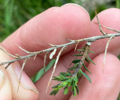2022 Annual Report for: Coleophoridae / Coleophorinae
For species seen in 2022 that had less than or equal to 100 records, full details are included; for more common species, the earliest, latest and highest count by vice-county are shown. The narrative for each species is taken from the main Hantsmoths website, and it is possible that some information on abundance and occurrence can get out of date, as it is impossible to keep up with all changes; however it should give a good introduction to each species. The tables in each species account summarise the previous status, and that for the current year.
For the maps, all records prior to 2022 are shown by a blue dot (the larger the dot, the more recent), with the current year's records shown in red. As previous records are superimposed on any report for 2022, new sites have greater emphasis (i.e. will show as 'more red').
In the species accounts, an asterisk next to a location indicates a new 10km square record; earliest ever dates are highlighted in orange, and latest ever in red. Initials in the species accounts refer to the recorders listed here. Please get in touch if you identify any omissions or errors, in particular if you have records that have yet to be submitted. Details of how to submit records can be found here.
37.002 [B&F: 0487] Coleophora lutarea (Haworth, 1828) - Local
Local in open woodland in southern England and south Wales. Reported from scattered locations in Hampshire, and only common in recent years from Pamber Forest: the Isle of Wight saw no records between the first in 1929, and 2012, when larvae were found in some numbers at Godshill. One was also seen in Firestone Copse in 2014. It is probably overlooked, and it may be found in new areas by searching for the adult moth which often rests on the flowers of the foodplant in sunshine, feeding on the nectar. The larva feeds within seeds of Greater Stitchwort, living within a movable case. Adult wingspan 9-11 mm.
Records prior to 2022
| Vice County | #Records | #Individuals | First Record | Last Record |
|---|---|---|---|---|
| 10 | 5 | 2 | 1929 | 2014 |
| 11 | 28 | 51 | 1975 | 2020 |
| 12 | 36 | 98 | 1991 | 2021 |
2022 records
| Vice County | #Records | #Individuals | Max Quantity |
|---|---|---|---|
| 12 | 9 | 65 | 20 |
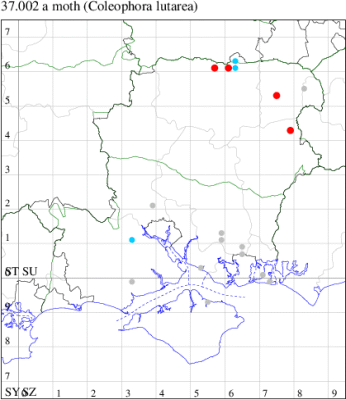
Records by year
Records by week (adult)
Records by week (larval)
Record Details
VC12: Smithley's Copse, Axmansford*, two, field observation, 25 May; Great Haughurst Copse, Axmansford*, 18, field observation, all pollen feeding on stichwort flowers, 22 May (ACB); Pamber Forest, 12, field observation, 21 May (BGD); five, field observation, 24 Apr; four, field observation, om stitchwort flowers, 03 May; 20, field observation, 06 May (GJD); two, field observation, 22 May (BGD); Bentley Station Meadow*, one, field observation, 07 May (BCA); Odiham Common, one, swept, 03 Jun (BGD)
37.003 [B&F: 0488] Coleophora limoniella (Stainton, 1884) - Nationally Scarce B
Nationally scarce (Nb) in saltmarshes throughout much of south-eastern England, with records north to Lincolnshire. Common in the salt-marshes of the Isle of Wight and southern Hampshire. Wingspan 10-11 mm. Imago fairly distinctive with its silver metallic markings; it comes readily to light and may be netted at dusk over its foodplant. Larva feeds within flowers and seedheads of Common Sea-lavender, living within a movable case, which can be quite easy to find amongst the foodplant.
Records prior to 2022
| Vice County | #Records | #Individuals | First Record | Last Record |
|---|---|---|---|---|
| 10 | 23 | 89 | 1900 | 2021 |
| 11 | 68 | 85 | 1982 | 2020 |
2022 records
| Vice County | #Records | #Individuals | Max Quantity |
|---|---|---|---|
| 11 | 8 | 8 | 1 |

Records by year
Records by week (adult)
Records by week (larval)
Record Details
VC11: Lee-on-Solent, one, 10 Jul (IHrg det. MJW); Portsmouth, one, 14 Jun; one, 15 Jun; one, 17 Jun; one, 22 Jun; one, 09 Jul; one, 11 Jul (IRT); Needs Ore NNR, one, 21 Jul (CNB); Browndown Coastal Ranges*, one, male, det'd genitalia, 10,406, 15 Jul (MLO, ADT, DWal & KJW det. RJD)
37.005 [B&F: 0490] Coleophora lutipennella (Zeller, 1838) - Common
Common in oak woodland, woodland rides and areas with scattered trees throughout much of England, Wales and southern Scotland. In Hampshire and on the Isle of Wight common and widespread. Wingspan 10-12 mm. Imago very similar to C. flavipennella. Like many of the Coleophora, imagines are virtually impossible to identify without recourse to dissection, and the larvae, which live in cases of characteristic form and which can sometimes be found on the foodplant, may be easier to identify by comparison against a reference collection. Larva mines leaves of Oak, living within a movable case, which differs from that of C. flavipennella in having leaf material at the back end of the case.
Records prior to 2022
| Vice County | #Records | #Individuals | First Record | Last Record |
|---|---|---|---|---|
| 10 | 6 | 9 | 2007 | 2021 |
| 11 | 213 | 279 | 1969 | 2021 |
| 12 | 42 | 32 | 1994 | 2020 |
2022 records
| Vice County | #Records | #Individuals | Max Quantity |
|---|---|---|---|
| 11 | 1 | 1 | 1 |
| 12 | 4 | 10 | 6 |
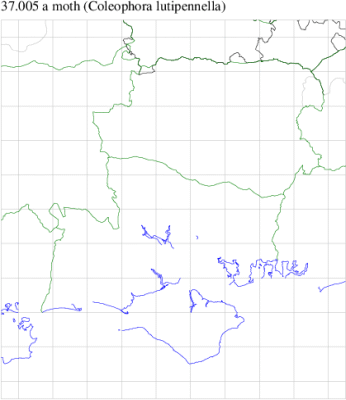
Records by year
Records by week (adult)
Records by week (larval)
Record Details
VC11: Romsey, one, gen det, 29 Jun (NRJ det. DJG);
VC12: Castle Bottom NNR, one, at dusk, gen det, 04 Jul (BGD); Fleet Pond, one, 18 Jul (MHals); Blackwater, six, gen det, 12 Jul; two, gen det, 18 Jul (BGD)
37.006 [B&F: 0491] Coleophora gryphipennella (Hübner, 1796) - Common
Common in open woodland, scrubland, waste ground, downland and gardens throughout much of Britain, except for the extreme north of Scotland, the Outer Hebrides, Orkney and Shetland. In Hampshire and on the Isle of Wight widespread and common. Wingspan 10.5-13 mm. Like many of the Coleophora, imagines are virtually impossible to identify without recourse to dissection, and the larvae, which live in cases of characteristic form and which can sometimes be found on the foodplant, may be easier to identify by comparison against a reference collection. Larva mines leaves of Dog-rose and Cultivated Rose, living within a movable case.
Records prior to 2022
| Vice County | #Records | #Individuals | First Record | Last Record |
|---|---|---|---|---|
| 10 | 32 | 7 | 1902 | 2018 |
| 11 | 153 | 79 | 1977 | 2021 |
| 12 | 40 | 6 | 1982 | 2013 |
2022 records
| Vice County | #Records | #Individuals | Max Quantity |
|---|---|---|---|
| 11 | 2 | 3 | 2 |
| 12 | 1 | 0 | 0 |
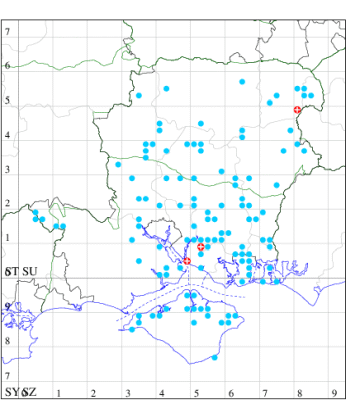
Records by year
Records by week (adult)
Records by week (larval)
Record Details
VC11: Hook with Warsash, case, two, field observation, 2 cases, 20 Oct; Whiteley, case, one, field observation, case, 16 Oct (DPH);
VC12: Crondall*, larval feeding signs, present, field observation, 13 Apr (AMD)
37.007 [B&F: 0492] Coleophora flavipennella (Duponchel, [1843]) - Common
Common in oak woodland, woodland rides and areas with scattered trees throughout much of England and Wales; rare in Ireland and Scotland. In Hampshire and on the Isle of Wight common and widespread. Wingspan 10.5-12.5 mm. Imago very similar to C. lutipennella. Like many of the Coleophora, imagines are virtually impossible to identify without recourse to dissection, and the larvae, which live in cases of characteristic form and which can sometimes be found on the foodplant, may be easier to identify by comparison against a reference collection. Larva mines leaves of Oak, living within a movable case, , which differs from that of C. lutipennella in having no leaf material at the back end of the case.
Records prior to 2022
| Vice County | #Records | #Individuals | First Record | Last Record |
|---|---|---|---|---|
| 10 | 14 | 2 | 1999 | 2014 |
| 11 | 208 | 230 | 1973 | 2021 |
| 12 | 35 | 34 | 1971 | 2015 |
2022 records
| Vice County | #Records | #Individuals | Max Quantity |
|---|---|---|---|
| 11 | 1 | 1 | 1 |
| 12 | 6 | 7 | 2 |
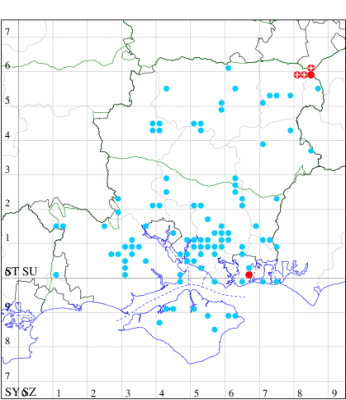
Records by year
Records by week (adult)
Records by week (larval)
Record Details
VC11: Portsmouth, one, genitalia checked, 12 Jul (IRT);
VC12: Minley Wood, case, one, field observation, vacated, 30 Jan; Yateley Common, case, one, field observation, vacated, 15 Jan; case, two, field observation, 19 Jan; Blackwater, one, gen det, 16 Jul; Shepherd Meadows, Blackwater*, larva, one, field observation, hanging on silk thread on Quercus robur, 25 Apr; one, swept, gen det, 12 Jun (BGD)
37.009 [B&F: 0496] Coleophora milvipennis Zeller, 1839 - Local
Local on heathland and in open woodland throughout much of Britain; rare in Ireland. Probably under-recorded in Hampshire and on the Isle of Wight, where the extent of known records correlate with those areas in which the recording effort is concentrated. Wingspan 10.5-13 mm. Like many of the Coleophora, imagines are virtually impossible to identify without recourse to dissection, and the larvae, which live in cases of characteristic form and which can sometimes be found on the foodplant, may be easier to identify by comparison against a reference collection. Larva mines leaves of Birch, living within a movable case.
Records prior to 2022
| Vice County | #Records | #Individuals | First Record | Last Record |
|---|---|---|---|---|
| 10 | 1 | 1 | 1977 | 1977 |
| 11 | 81 | 72 | 1979 | 2014 |
| 12 | 7 | 5 | 1980 | 2008 |
2022 records
| Vice County | #Records | #Individuals | Max Quantity |
|---|---|---|---|
| 11 | 4 | 7 | 2 |
| 12 | 2 | 6 | 5 |
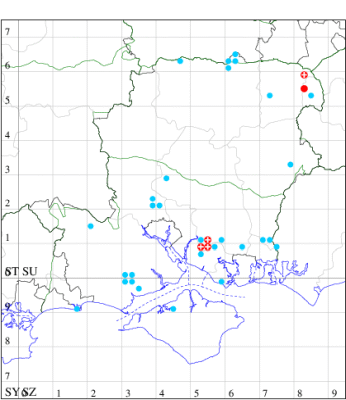
Records by year
Records by week (adult)
Records by week (larval)
Record Details
VC11: Botley Wood, case, two, on host-plant, on birch, alongside the S corner of the substation. Both still present 14.ix.22 and one on 14.ix.22, 11 Sep; case, two, on host-plant, 2 cases on birch close to the substation. Comm. by email 15.ix.2022, 14 Sep; case, two, field observation, 2 cases, still present 14/9 and one still 19/9, 11 Sep; case, one, field observation, case, 18 Sep (DPH);
VC12: Fleet Pond, one, 09 Jun (MHals); Yateley Common, case, five, field observation, on Betula pendula, 09 Mar (BGD)
37.011 [B&F: 0497] Coleophora badiipennella (Duponchel, [1843]) - Local
Local in hedgerows, woodland margins and scrubland throughout much of England. In Hampshire largely restricted to the south-east of the county and known from the Isle of Wight only from the north-west. Wingspan 9-11 mm. Differs from C. adjectella in having dark-tipped scales over much of the forewing; C. trigeminella has dark-tipped scales nearly confined to wing-apex (MBGBI Vol 3). Larva mines leaves of English and Small-leaved Elm, preferring young trees, and living within a movable case; case length 5-6 mm.
Records prior to 2022
| Vice County | #Records | #Individuals | First Record | Last Record |
|---|---|---|---|---|
| 10 | 8 | 3 | 1997 | 2007 |
| 11 | 80 | 118 | 1974 | 2021 |
| 12 | 7 | 5 | 1996 | 2015 |
2022 records
| Vice County | #Records | #Individuals | Max Quantity |
|---|---|---|---|
| 12 | 1 | 1 | 1 |
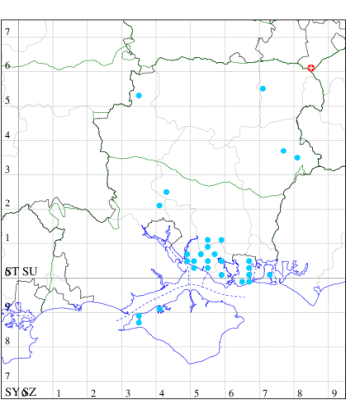
Records by year
Records by week (adult)
Records by week (larval)
Record Details
VC12: Shepherd Meadows, Blackwater*, case, one, field observation, on Ulmus campestris, 10 Aug (BGD)
37.015 [B&F: 0493] Coleophora serratella (Linnaeus, 1761) - Common
One of commonest species of Coleophora, in woodland, hedgerows, heathland and fens throughout much of the British Isles, except for the far northern islands of Scotland. In Hampshire and on the Isle of Wight common and widespread. Wingspan 10.5-14 mm. Like many of the Coleophora, imagines are virtually impossible to identify without recourse to dissection: the indistinct rings near the tip of the antenna help to distinguish it, but examination of the genitalia is required for positive identification of non-reared specimens. The larva mines leaves of Birch, Alder, Elm and Hazel, living within a movable case, creating small mines which leave a characteristic pattern on the surface of the leaves of its foodplants, birch, elm, alder or hazel. Confusion can occur when it is occasionally found feeding on other trees, or on herbaceous plants onto which it has accidentally fallen.
Records prior to 2022
| Vice County | #Records | #Individuals | First Record | Last Record |
|---|---|---|---|---|
| 10 | 96 | 56 | 1900 | 2021 |
| 11 | 440 | 348 | 1972 | 2021 |
| 12 | 117 | 86 | 1974 | 2021 |
2022 records
| Vice County | #Records | #Individuals | Max Quantity |
|---|---|---|---|
| 10 | 3 | 3 | 1 |
| 11 | 1 | 3 | 3 |
| 12 | 10 | 75 | 40 |
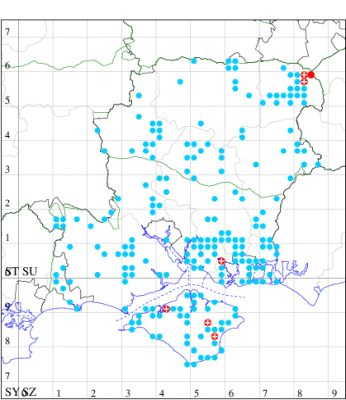
Records by year
Records by week (adult)
Records by week (larval)
Record Details
VC10: Newtown, case, one, field observation, on Ulmus, north edge of copse, 03 Jun; Osiers, Newchurch, larva, one, field observation, on Ulmus procera, 13 Oct; America Wood, case, one, field observation, larval case on Betula pendula (Silver Birch), 15 May (IOu);
VC11: Fareham, larva, three, on host-plant, 3 cases and abundant empty mines on Ulmus procera, 14 Jun (IRT);
VC12: Minley Wood, case, one, field observation, on Betula pendula, 18 Apr; Yateley Common, vacated mine, 24, on Betula pendula, 28 Apr; mine, three, on Betula pendula, 28 Apr; vacated mine, one, on Betula pendula, 21 Apr; case, one, field observation, 02 May; two, at dusk, gen det, 10 Jun; case, 40, field observation, on Betula pendula, 30 Apr; one, swept, gen det, 02 Jun; one, swept, gen det, 08 Jun; Blackwater, one, gen det, 16 Jun (BGD)
37.017 [B&F: 0494a] Coleophora prunifoliae Doets, 1944 - Nationally Scarce B
Nationally scarce (Nb) in hedgerows and scrubland throughout England. In Hampshire apparently restricted to the coastal strip east of Southampton, from Brownwich and Titchfield Haven to Hayling Island. Not recorded from the Isle of Wight to date. Wingspan 9-12 mm. Adults are indistinguishable externally from C. coracipennella and C. spinella and identification therefore relies on dissection of the genitalia. Larva mines leaves of Blackthorn and also Dwarf Cherry and Apple, living and feeding within a movable case; no feature is known for distinguishing cases of the three species, and the moths must therefore be bred and dissected.
Records prior to 2022
| Vice County | #Records | #Individuals | First Record | Last Record |
|---|---|---|---|---|
| 10 | 1 | 0 | 2013 | 2013 |
| 11 | 20 | 19 | 1980 | 2018 |
2022 records
| Vice County | #Records | #Individuals | Max Quantity |
|---|---|---|---|
| 11 | 2 | 2 | 1 |
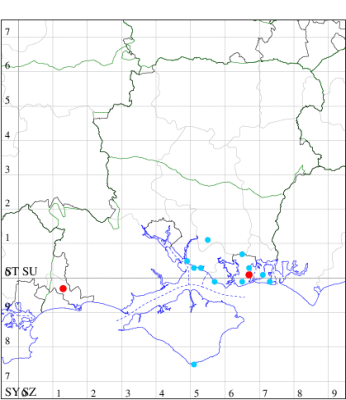
Records by year
Records by week (adult)
Records by week (larval)
Record Details
VC11: Portsmouth, one, 06 Jul (IRT); Hurn*, one, 07 Jul (MJef det. PHS)
37.020 [B&F: 0503] Coleophora fuscocuprella Herrich-Schäffer, 1855 - Nationally Scarce B
Nationally scarce (Nb) in woodland margins, woodland rides and heathland throughout much of southern England, with records north to Leicestershire. In Hampshire first recorded in the county from Havant Thicket in 1979, and since from Crab Wood, Emer Bog and Botley Wood in the south, and Pamber Forest, Fleet Pond and Blagden Lodge, Wildhern, in the north. Not recorded from the Isle of Wight to date. Wingspan 7.5-10 mm. Like many of the Coleophora, imagines are virtually impossible to identify without recourse to dissection, and the larvae, which live in cases of characteristic form and which can sometimes be found on the foodplant, may be easier to identify by comparison against a reference collection. Larva mines leaves of Hazel and Downy Birch, living within a movable case.
Records prior to 2022
| Vice County | #Records | #Individuals | First Record | Last Record |
|---|---|---|---|---|
| 11 | 45 | 53 | 1979 | 2021 |
| 12 | 9 | 7 | 1997 | 2019 |
2022 records
| Vice County | #Records | #Individuals | Max Quantity |
|---|---|---|---|
| 11 | 5 | 7 | 2 |
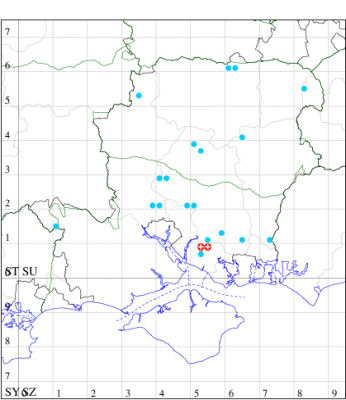
Records by year
Records by week (adult)
Records by week (larval)
Record Details
VC11: Whiteley, case, two, field observation, 2 cases, 16 Oct; Botley Wood, case, one, field observation, case, by substation, additional to 2 along substation rd on same day, 09 Oct; case, one, field observation, case, 08 Oct; case, one, field observation, 2 cases, one same as 08/10/2022. One larva seen, 09 Oct; case, two, on host-plant, at least two larval cases, 09 Oct (DPH)
37.022 [B&F: 0504] Coleophora lusciniaepennella (Treitschke, 1833) - Common
Common in freshwater margins, woodland, bogs and fens throughout much of the British Isles, except for the extreme north of Scotland and the Orkney and Shetland Islands. In Hampshire and on the Isle of Wight common and widespread, especially in the south of the county. Wingspan 10-13.5 mm. Like many of the Coleophora, imagines are virtually impossible to identify without recourse to dissection, and the larvae, which live in cases of characteristic form and which can sometimes be found on the foodplant, may be easier to identify by comparison against a reference collection. Larva mines leaves of Sallow, Willow, Osier, Bog-myrtle and Birch, living within a movable case.
Records prior to 2022
| Vice County | #Records | #Individuals | First Record | Last Record |
|---|---|---|---|---|
| 10 | 19 | 18 | 1902 | 2021 |
| 11 | 145 | 104 | 1973 | 2021 |
| 12 | 16 | 9 | 1988 | 2011 |
2022 records
| Vice County | #Records | #Individuals | Max Quantity |
|---|---|---|---|
| 11 | 2 | 3 | 2 |

Records by year
Records by week (adult)
Records by week (larval)
Record Details
VC11: Beaulieu Heath, NF, larva, two, field observation, larval cases on bog Myrtle in flush running north down hill, 04 Jun (WLan); Browndown Coastal Ranges, one, female, det'd genitalia, 03 Jun (RJD, MLO, ADT, DWal & KJW)
37.026 [B&F: 0509] Coleophora violacea (Ström, 1783) - Nationally Scarce B
Nationally scarce (Nb) in open woodland, parks and scrubland throughout much of Britain, except for the far north of Scotland and the Hebrides, Orkney and Shetland. In Hampshire apparently rather scarce, typical finds being of single cases or single moths at light; an empty case was found on the Isle of Wight in 1995. Like many of the Coleophora, imagines are virtually impossible to identify without recourse to dissection, and the fact that the larva of this species is highly polyphagous means that cases are difficult to find. Wingspan 9-11 mm. Larva mines leaves of deciduous trees and shrubs, living within a movable case. The case is very similar to that of C. potentillae.
Records prior to 2022
| Vice County | #Records | #Individuals | First Record | Last Record |
|---|---|---|---|---|
| 10 | 1 | 1 | 1995 | 1995 |
| 11 | 13 | 13 | 1979 | 2012 |
| 12 | 5 | 3 | 1994 | 2005 |
2022 records
| Vice County | #Records | #Individuals | Max Quantity |
|---|---|---|---|
| 12 | 1 | 3 | 3 |
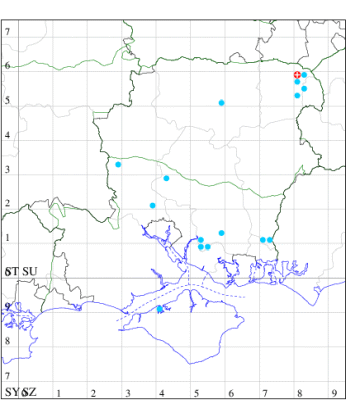
Records by year
Records by week (adult)
Records by week (larval)
Record Details
VC12: Minley Wood, mine, three, on Nothofagus obliqua, 26 Sep (BGD)
37.028 [B&F: 0510] Coleophora juncicolella Stainton, 1851 - Local
Local on heathland and moorland throughout much of Britain, as far north as west Ross; rare in Ireland. In Hampshire virtually restricted to heaths in the New Forest and the north-east of the county. First recorded on the Isle of Wight in 2015, with another in 2022, both at Headon Warren on the western tip of the island. Wingspan 6-8 mm. Candidates for this taxon may be picked out as it is significantly smaller than other Coleophora, but specimens are required for accurate determination. Larva mines leaves of Heather and Bell Heather, living within a movable case.
Records prior to 2022
| Vice County | #Records | #Individuals | First Record | Last Record |
|---|---|---|---|---|
| 10 | 1 | 4 | 2015 | 2015 |
| 11 | 30 | 55 | 1975 | 2015 |
| 12 | 6 | 8 | 1998 | 2007 |
2022 records
| Vice County | #Records | #Individuals | Max Quantity |
|---|---|---|---|
| 10 | 1 | 10 | 10 |
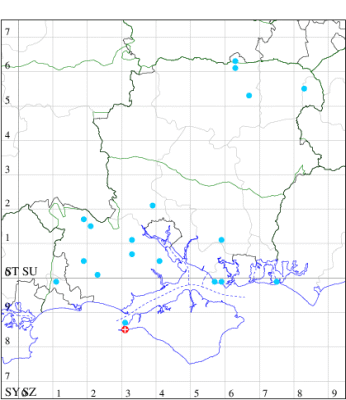
Records by year
Records by week (adult)
Records by week (larval)
Record Details
VC10: Headon Warren, larva, 10, beaten, beaten from older Calluna vulgaris, 23 Apr (PBar)
37.029 [B&F: 0511] Coleophora orbitella Zeller, 1849 - Nationally Scarce B
Nationally scarce (Nb) in heaths and alder carr throughout Britain, except the Outer Hebrides, Orkney and Shetland; western and south-western Ireland (MBGBI Vol 3). In Hampshire first recorded in 1975, from Martyr Worthy, and subsequently from Newtown Common both in northern Hampshire; since when recorded in the south-east of the county, at Botley Wood, Wickham Common and Havant Thicket. Not recorded from the Isle of Wight to date. Wingspan 10.5-14 mm. Like many of the Coleophora, imagines are virtually impossible to identify without recourse to dissection, and the larvae, which live in cases of characteristic form and which can sometimes be found on the foodplant, may be easier to identify by comparison against a reference collection. Larva mines leaves of Birch and Alder, living within a movable case. In Hampshire cases have been found mainly on birch.
Records prior to 2022
| Vice County | #Records | #Individuals | First Record | Last Record |
|---|---|---|---|---|
| 11 | 13 | 10 | 1980 | 2007 |
| 12 | 5 | 13 | 1975 | 2006 |
2022 records
| Vice County | #Records | #Individuals | Max Quantity |
|---|---|---|---|
| 12 | 1 | 1 | 1 |
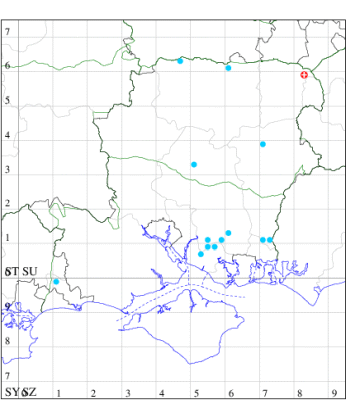
Records by year
Records by week (adult)
Records by week (larval)
Record Details
VC12: Yateley Common*, case, one, field observation, on Betula pendula, 01 Jun (BGD)
37.032 [B&F: 0515] Coleophora albitarsella Zeller, 1849 - Local
Local in hedgerows, open woodland, fens and downland throughout much of England and Wales, more numerous in the south. In Hampshire and on the Isle of Wight there are scattered records throughout, with no apparent population centre. Wingspan 10-13 mm. The pale tarsi that gives the species its scientific name are a ready means of recognition. Larva mines leaves of Wild Basil, Wild Marjoram, Self-heal, Ground-ivy and Mint, living within a movable case; case length 9 mm.
Records prior to 2022
| Vice County | #Records | #Individuals | First Record | Last Record |
|---|---|---|---|---|
| 10 | 38 | 19 | 1902 | 2021 |
| 11 | 80 | 84 | 1978 | 2021 |
| 12 | 63 | 69 | 1985 | 2021 |
2022 records
| Vice County | #Records | #Individuals | Max Quantity |
|---|---|---|---|
| 10 | 1 | 1 | 1 |
| 11 | 5 | 5 | 1 |
| 12 | 7 | 7 | 1 |
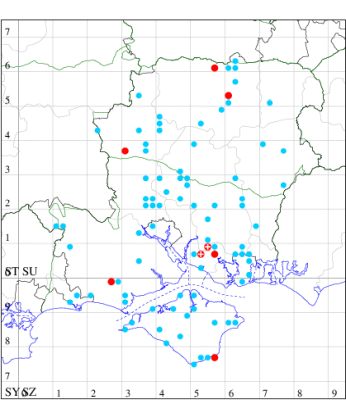
Records by year
Records by week (adult)
Records by week (larval)
Record Details
VC10: Wheelers Bay, one, 22 Jun (ABut);
VC11: Titchfield Common: Kites Croft LNR, case, one, field observation, case, 15 Oct; Botley Wood, case, one, on host-plant, larval case on ground ivy, 09 Oct; case, one, field observation, case, larva seen, 08 Oct (DPH); Fareham, one, det gen, 28 Jul (MLO det. RJD); Sway, one, 17 Jul (SKee);
VC12: Nether Wallop, one, 06 Jun (GCE); Great Haughurst Copse, Axmansford, one, 09 Jul (ACB det. MJW); Basingstoke, one, 12 Jul; one, 16 Jul; one, 19 Jul (MJW)
37.033 [B&F: 0516] Coleophora trifolii (Curtis, 1832) - Local
Local on rough grassland, waste ground and roadside verges throughout much of the British Isles, less numerous in Scotland, more numerous in the south. In Hampshire widely but thinly distributed, records increasing in recent years; on the Island still rarely reported. Wingspan 15-20 mm. The comparatively large size, metallic green forewings with copper apex and white tip to antennae, make this species one of the few which can be identified without recourse to dissection of the genitalia, although the differences in size between this and other related species may only be obvious in series of mounted, set specimens. Larva feeds within seedpods of Ribbed Melilot and Tall Melilot, living within a movable case.
Records prior to 2022
| Vice County | #Records | #Individuals | First Record | Last Record |
|---|---|---|---|---|
| 10 | 43 | 46 | 1856 | 2020 |
| 11 | 217 | 271 | 1972 | 2021 |
| 12 | 122 | 159 | 1993 | 2021 |
2022 records
| Vice County | #Records | #Individuals | Max Quantity |
|---|---|---|---|
| 10 | 17 | 29 | 4 |
| 11 | 34 | 62 | 10 |
| 12 | 9 | 13 | 3 |
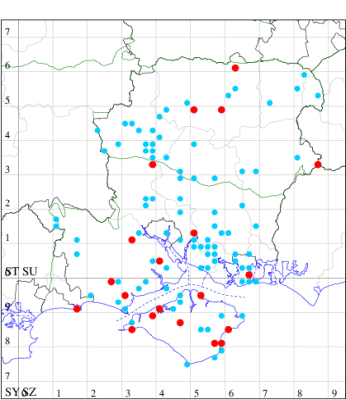
Records by year
Records by week (adult)
Records by week (larval)
Record Details
VC10: West High Down quarries, two, 12 Jul (IOu); Cranmore, present, 31 Jul (CHic); Plaish, Carisbrooke, four, 20 Jul; one, 22 Jul; Lower Hamstead, two, 24 Jul; three, 25 Jul; three, 26 Jul (KRyl); Shanklin, one, 11 Jul; one, 12 Jul; one, 25 Jul; three, 03 Aug; two, 04 Aug; one, 05 Aug; two, 09 Aug; Shanklin Upper Chine, one, 22 Jun; Osborne Valley Walk*, one, gen. det. completed 15 May, 09 May; Sandown, one, 29 Jul (IOu);
VC11: Franchises Wood, NF, present, 19 May (RBW); Crawley, 10, 30 Jul (GCE); Dibden Purlieu, one, 19 Jul; one, 20 Jul; one, 21 Jul; one, 25 Jul; one, 02 Aug; one, 09 Aug (RAC); Botley, one, 14 Jul; one, 12 Aug; one, 18 Aug; one, 30 Jul; one, 12 Aug; one, 14 Aug; one, 16 Aug; one, 23 Aug (SLB); Portsmouth, three, 10 Aug (IRT); Hengistbury Head, one, 20 Jul (MJef); Sway, one, 19 May; one, 10 Jun; three, 11 Jul; one, 12 Jul; seven, 17 Jul; seven, 18 Jul; two, 20 Jul; two, 27 Jul; two, 29 Jul; one, 01 Aug; one, 03 Aug; one, 10 Aug; one, 11 Aug; one, 14 Aug (SKee); Pennington, one, 12 Aug; two, 13 Aug (RFC);
VC12: Overton, one, 08 Jul; three, 17 Jul; two, 28 Jul; one, 17 Aug (ACr); Basingstoke, two, 17 Jul; one, 26 Jul (GAH); Pamber Forest*, one, 10 Jul (GJD); Hammer Vale, Woolmer, one, cf, 11 Aug; one, 15 Aug (ASwa)
37.035 [B&F: 0517] Clover Case-bearer Coleophora alcyonipennella (Kollar, 1832) - Local
Local on rough grassland and waste ground, although the exact status and distribution of this species is unclear due to past confusion with C. frischella, which is very similar and can only be separated through dissection of the genitalia. In Hampshire widespread and almost certainly under-recorded; this is certainly the case on Wight, where it was determined for the first time at Totland in 2021 and found to be common at the same site in 2022. Wingspan 11.5-14.5 mm. Larva feeds within seedheads of White Clover, living within a movable case.
Records prior to 2022
| Vice County | #Records | #Individuals | First Record | Last Record |
|---|---|---|---|---|
| 10 | 2 | 2 | 2021 | 2021 |
| 11 | 493 | 639 | 1973 | 2021 |
| 12 | 64 | 85 | 1994 | 2021 |
2022 records
| Vice County | #Records | #Individuals | Max Quantity |
|---|---|---|---|
| 10 | 9 | 26 | 7 |
| 11 | 34 | 53 | 8 |
| 12 | 14 | 19 | 4 |
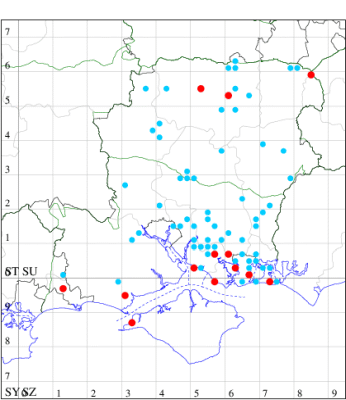
Records by year
Records by week (adult)
Records by week (larval)
Record Details
VC10: Totland, four, 23 Jul; one, male gen.det, 25 Jul; seven, 26 Jul; five, 27 Jul; one, 28 Jul; five, 29 Jul; one, 30 Jul; one, 31 Aug; one, male gen.det, 02 Sep (RTer);
VC11: Brownwich cliffs, one, 17 Jun (RJD, MLO, ADT, DWal, KJW); Fareham, one, 13 Jul; one, 08 Aug; one, 14 Aug (MLO); Portsdown, one, field observation, male, det'd genitalia, 08 Aug (MChg det. RJD); Horsea Island, one, male, det'd genitalia, 22 Jul (RJD, MLO, ADT, DWal, KJW det. RJD); Portsmouth, one, 05 May; one, 09 May; one, 22 May; one, 08 Jul; one, 16 Jul; one, 17 Jul; two, 18 Jul; one, 30 Jul; one, 07 Aug; one, 10 Aug; six, 13 Aug; two, including one female gen det, 14 Aug; one, 21 Aug (IRT); Hurn, one, 14 Jul (MJef det. AMD); Pennington, three, 17 Jul; one, 19 Jul; one, 20 Jul; two, 22 Jul; one, 02 Aug; one, 06 Aug; one, 07 Aug; three, 12 Aug; one, 13 Aug (RFC); Browndown Coastal Ranges*, one, female, genitalia 10,371, 08 Jul (RJD, ADT, DWal & KJW); one, female, det'd genitalia, 10,407, 15 Jul (MLO, ADT, DWal & KJW det. RJD); eight, 12 Aug (KCok, RJD, MLO, ADT, DWal det. RJD); one, male, genitalia 10,4,19, 26 Aug (RJD, MLO, ADT & KJW); Hayling Island, one, gen. Det, 18 Jul (STho);
VC12: Tidgrove Warren, nr Overton*, one, 10 Aug (ACB det. MJW); Basingstoke, one, 12 Jul; one, 14 Jul; one, 16 Jul; one, 30 Jul; two, 11 Aug (MJW); Blackwater*, two, 11 Jul; one, 13 Jul; four, 30 Jul; one, 01 Aug (BGD)
37.038 [B&F: 0522] Coleophora lineolea (Haworth, 1828) - Local
Local in hedgerows and waste ground throughout much of southern England and Wales, with records north to Yorkshire. In Hampshire the majority of records are from Portsea and Hayling Islands, with scattered records elsewhere across our two counties. Wingspan 11-14.5 mm. Candidates for this species can be picked out by the yellow-ochreous wing veins, but is more easily verified at the larval stage with its distinctive case made of rings of mined leaf, fully developed in May. Larva mines leaves of labiates, in particular Hedge Woundwort and Black Horehound, but also uses White Horehound and Betony.
Records prior to 2022
| Vice County | #Records | #Individuals | First Record | Last Record |
|---|---|---|---|---|
| 10 | 18 | 18 | 1977 | 2021 |
| 11 | 287 | 341 | 1972 | 2021 |
| 12 | 12 | 7 | 1984 | 2020 |
2022 records
| Vice County | #Records | #Individuals | Max Quantity |
|---|---|---|---|
| 10 | 1 | 1 | 1 |
| 11 | 6 | 14 | 10 |
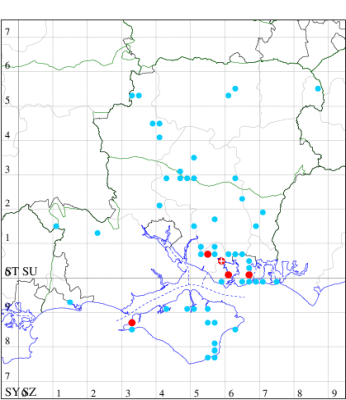
Records by year
Records by week (adult)
Records by week (larval)
Record Details
VC10: Totland, one, 1 x female gen. det, 02 Sep (RTer);
VC11: Catisfield, one, gen det , 14 Aug (ALR det. RJD); Fareham, vacated mine, 10, stachys sylvatica in two places with extensive mines, one plant having at least two cases still below the leaves, 14 Jun (RJD); Gosport, one, 20 Jun (KIls); Portsmouth, one, 13 Aug; one, 14 Aug; Milton Common, Portsmouth, present, field observation, feeding signs on Black Whorehound, 22 May (IRT)
37.040 [B&F: 0524] Coleophora lithargyrinella Zeller, 1849 - Nationally Scarce B
Nationally scarce (Nb) in open woodland, hedgerows, cliffs and shingle beaches in parts of the British Isles, one of the more widespread coleophorids in Britain. In Hampshire first recorded on Odiham Common in 1963, with occasional reports from the north since: remarkably not found in the south of the county until 2022, when a case was found at Brownwich. Not recorded on the Isle of Wight to date. Wingspan 11-13.5 mm. Very similar to C. solitariella. Like many of the Coleophora, imagines are virtually impossible to identify without recourse to dissection, and the larvae, which live in cases of characteristic form and which can sometimes be found on the foodplant, may be easier to identify by comparison against a reference collection. Larva mines leaves of Greater Stitchwort and Sea Campion, living within a movable case.
Records prior to 2022
| Vice County | #Records | #Individuals | First Record | Last Record |
|---|---|---|---|---|
| 12 | 7 | 13 | 1963 | 2012 |
2022 records
| Vice County | #Records | #Individuals | Max Quantity |
|---|---|---|---|
| 11 | 1 | 1 | 1 |
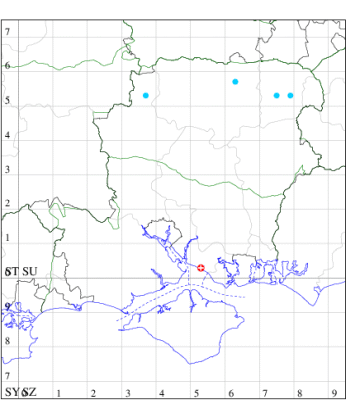
Records by year
Records by week (adult)
Records by week (larval)
Record Details
VC11: New Vice-county Record: Thatcher's Copse*, case, one, on host-plant, case on greater stitchwort, 25 Apr; Brownwich*, case, one, field observation, occupied case, 25 Apr (DPH)
37.041 [B&F: 0546] Coleophora genistae Stainton, 1857 - Nationally Scarce A
Nationally scarce (Na) in rough grassland, damp heathland, mosses and moorland in England northwards to Loch Ness, Scotland; rare in North Wales (MBGBI Vol 3). In Hampshire virtually restricted to the New Forest and, in the north of the county, Bartley Heath. Not recorded from the Isle of Wight since 1969. Wingspan 11-13 mm. Very similar to C. saturatella. Like many of the Coleophora, imagines are virtually impossible to identify without recourse to dissection, and the larvae, which live in cases of characteristic form and which can sometimes be found on the foodplant, may be easier to identify by comparison against a reference collection. Larva mines leaves of Petty Whin, living within a movable case, often several together.
Records prior to 2022
| Vice County | #Records | #Individuals | First Record | Last Record |
|---|---|---|---|---|
| 10 | 2 | 7 | 1969 | 1969 |
| 11 | 11 | 12 | 1999 | 2021 |
| 12 | 8 | 21 | 1985 | 2007 |
2022 records
| Vice County | #Records | #Individuals | Max Quantity |
|---|---|---|---|
| 11 | 3 | 10 | 7 |
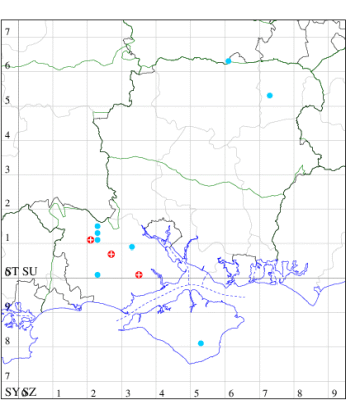
Records by year
Records by week (adult)
Records by week (larval)
Record Details
VC11: White Moor, NF, case, two, field observation, 05 May; Broomy Bottom, NF, case, one, field observation, 07 May (AMD); Beaulieu Heath, NF, case, seven, field observation, larval cases on petty whin growing on slightly higher, drier northern edge of bog (just below path). Maybe c20 rather small plants and 6 or 7 cases found in a fairly quick search, 04 Jun (WLan)
37.044 [B&F: 0547] Coleophora discordella Zeller, 1849 - Common
Common in rough grassland, downland and woodland clearings and in marshes and other damp places throughout much of the British Isles, except the Shetland Islands. In Hampshire and on the Isle of Wight rather infrequently recorded, with the usual concentration of records in the south-east of the county, probably under-recorded elsewhere. Wingspan 11-12.5 mm. Like many of the Coleophora, imagines are virtually impossible to identify without recourse to dissection, and the larvae, which live in cases of characteristic form and which can sometimes be found on the foodplant, may be easier to identify by comparison against a reference collection. Larva mines leaves of Common Bird's-foot Trefoil and Greater Bird's-foot Trefoil, living within a movable case.
Records prior to 2022
| Vice County | #Records | #Individuals | First Record | Last Record |
|---|---|---|---|---|
| 10 | 14 | 6 | 1850 | 2021 |
| 11 | 46 | 45 | 1977 | 2021 |
| 12 | 5 | 4 | 1971 | 2011 |
2022 records
| Vice County | #Records | #Individuals | Max Quantity |
|---|---|---|---|
| 10 | 1 | 1 | 1 |
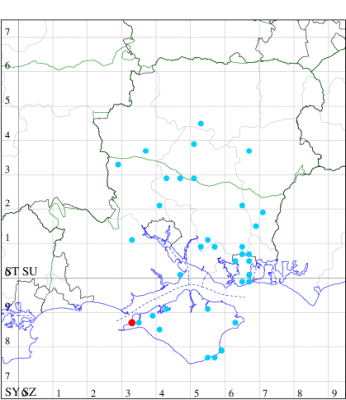
Records by year
Records by week (adult)
Records by week (larval)
Record Details
VC10: Totland, one, male gen.det, 01 Jun (RTer)
37.046 [B&F: 0519] Coleophora deauratella Lienig & Zeller, 1846 - Local
Local on waste ground, grassland and roadside verges throughout S. England and S. Wales. In Hampshire recorded fairly frequently only in the south-east, but the true distribution poorly known due to confusion with other related species. Not recorded from the Isle of Wight since 1900. Wingspan 10.5-12.5 mm. Day-flying, but comes to light, although less frequently than other related species. Can be separated from C. alcyonipennella and C. frischella only by dissection of the genitalia. Larva feeds within seedheads of Red Clover, living within a movable case; case length 6 mm.
Records prior to 2022
| Vice County | #Records | #Individuals | First Record | Last Record |
|---|---|---|---|---|
| 10 | 8 | 7 | 1900 | 2021 |
| 11 | 142 | 149 | 1972 | 2021 |
| 12 | 25 | 43 | 1986 | 2011 |
2022 records
| Vice County | #Records | #Individuals | Max Quantity |
|---|---|---|---|
| 10 | 3 | 3 | 1 |
| 11 | 6 | 6 | 1 |
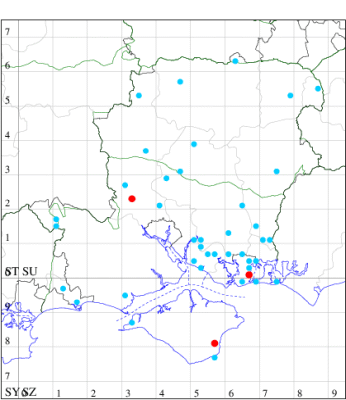
Records by year
Records by week (adult)
Records by week (larval)
Record Details
VC10: Shanklin, one, gen. det. completed 17 August, 12 Aug; one, field observation, gen. det. completed 20 August, 15 Aug; one, 20 Aug (IOu);
VC11: Stanbrige Earls, one, 11 Jun (JRM); Portsmouth, one, 22 Jun; one, 05 Jul; one, 18 Jul; one, 19 Jul; one, 07 Aug (IRT)
37.048 [B&F: 0518] Coleophora mayrella (Hübner, [1813]) - Common
Common on grassland, roadside verges and waste ground throughout much of the British Isles. In Hampshire reported at light across much of the county, but no recent records from the Isle of Wight. Wingspan 10.5-12 mm. Like many of the Coleophora, imagines are virtually impossible to identify without recourse to dissection, and the larvae, which live in cases of characteristic form and which can sometimes be found on the foodplant, may be easier to identify by comparison against a reference collection. Larva feeds within seedheads of White Clover, living within a movable case, and can be collected and bred through as described in MBGBI Vol 3.
Records prior to 2022
| Vice County | #Records | #Individuals | First Record | Last Record |
|---|---|---|---|---|
| 10 | 11 | 9 | 1930 | 2021 |
| 11 | 149 | 168 | 1973 | 2021 |
| 12 | 81 | 109 | 1990 | 2020 |
2022 records
| Vice County | #Records | #Individuals | Max Quantity |
|---|---|---|---|
| 11 | 6 | 9 | 3 |
| 12 | 2 | 2 | 1 |
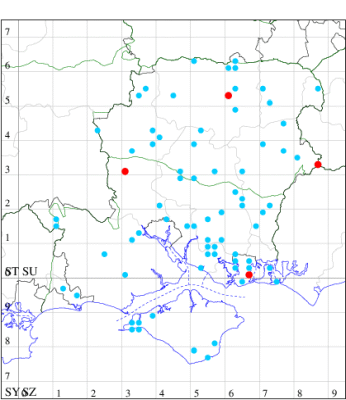
Records by year
Records by week (adult)
Records by week (larval)
Record Details
VC11: Broughton, one, 21 May (GCE); Portsmouth, one, 15 Jun; three, 22 Jun; two, 23 Jun; one, 08 Jul; one, 12 Jul (IRT);
VC12: Basingstoke, one, 18 Jul (MJW); Hammer Vale, Woolmer, one, cf, 15 Aug (ASwa)
37.051 [B&F: 0537] Coleophora kuehnella (Goeze, 1783) - Local
Local in oak woodland and oak scrub throughout England. Sparsely recorded in Hampshire, and more frequent in the southern half. Not recorded from the Isle of Wight since 1900. Wingspan 14-17 mm. As an adult, the main confusion species are C. betulella, in which the costal cilia are not tipped white, and C. ibipennella, which shares the white-tipped cilia of C. kuehnella, but which is normally smaller and has the base of the cilia blackish rather than grey (MBGBI Vol 3). Larva mines leaves of Oak, living within a distinctive case with a characteristic 'bubble' appearance; case length 8 mm.
Records prior to 2022
| Vice County | #Records | #Individuals | First Record | Last Record |
|---|---|---|---|---|
| 10 | 4 | 2 | 1900 | 2016 |
| 11 | 51 | 60 | 1977 | 2017 |
| 12 | 9 | 5 | 1980 | 2010 |
2022 records
| Vice County | #Records | #Individuals | Max Quantity |
|---|---|---|---|
| 11 | 2 | 2 | 1 |
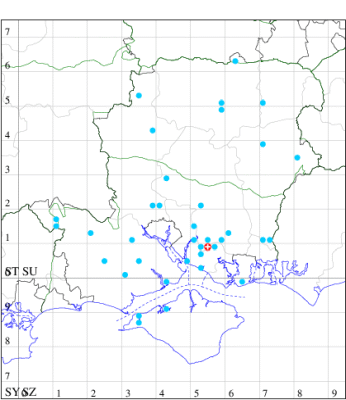
Records by year
Records by week (adult)
Records by week (larval)
Record Details
VC11: Botley Wood, case, one, field observation, case, 16 Jun (DPH)
37.055 [B&F: 0541] Coleophora pyrrhulipennella Zeller, 1839 - Local
Local on heathland, moorland and bogs throughout much of Britain, north to the Great Glen. In Hampshire there are recent records from the New Forest, Wickham Common Pamber Forest and the north-eastern heaths, elsewhere there are scattered records from south-east Hampshire and the Isle of Wight. Wingspan 11-14.5 mm. One of the more distinctive Coleophora. Larva feeds on leaves of Heather and Bell Heather, living within a movable case; case length 9 mm.
Records prior to 2022
| Vice County | #Records | #Individuals | First Record | Last Record |
|---|---|---|---|---|
| 10 | 4 | 11 | 1969 | 2015 |
| 11 | 39 | 55 | 1978 | 2014 |
| 12 | 17 | 13 | 1980 | 2021 |
2022 records
| Vice County | #Records | #Individuals | Max Quantity |
|---|---|---|---|
| 12 | 1 | 1 | 1 |

Records by year
Records by week (adult)
Records by week (larval)
Record Details
VC12: Hazeley Heath, Hartley Wintney, case, one, field observation, on gorse next to heather; emerged around 9.6.22, 15 May (FHut)
37.059 [B&F: 0538] Coleophora vibicella (Hübner, [1813]) - pRDB2
Vulnerable (proposed as a future Red Data Book species) in rough pastures and woodland rides, declining, and now probably restricted to Hampshire and adjoining counties, a priority species under the UK Biodiversity Action Plan. In Hampshire recorded recently from Beaulieu, Hayling Island, Stubbington and, most notably, Botley Wood; on the Isle of Wight recorded recently only from Newtown NR. Wingspan 17-22 mm. Almost always recorded in the larval stage, when the cases are fairly easy to find where they are present; the adult can only be separated from similar Coleophora by dissection of the genitalia. Larva mines leaves of Dyer's Greenweed, living within a movable case; case length 19 mm.
Records prior to 2022
| Vice County | #Records | #Individuals | First Record | Last Record |
|---|---|---|---|---|
| 10 | 82 | 2715 | 1900 | 2021 |
| 11 | 66 | 1266 | 1900 | 2021 |
2022 records
| Vice County | #Records | #Individuals | Max Quantity |
|---|---|---|---|
| 10 | 5 | 34 | 30 |
| 11 | 1 | 1678 | 1678 |
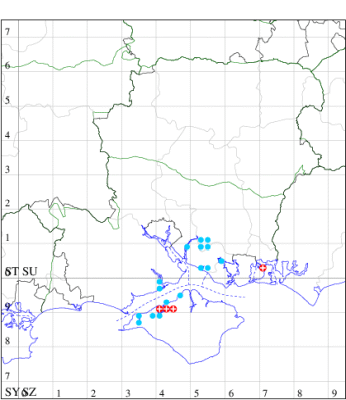
Records by year
Records by week (adult)
Records by week (larval)
Record Details
VC10: Newtown, case, one, field observation, feeding signs on On dyer's greenweed (Genista tinctoria) And a single active large case, 16 Jun (SDav); Newtown Meadows, case, 30, field observation, a few larval cases on Genista tinctoria (Dyer's Greenweed). Most in the meadow at SZ 4290 9046 and a few in the adjacent meadow to the west at SZ 4286 9043. None on the host plant in the meadow at SZ 4238 9044, 03 Jun (IOu); Newtown Ranges, case, one, field observation, 13 Jun; case, one, field observation, 13 Jun; case, one, field observation, 13 Jun (IPer);
VC11: Hayling Billy, case, 1678, field observation, 30 Jun (AMD)
37.061 [B&F: 0530] Coleophora lixella Zeller, 1849 - Nationally Scarce B
Nationally scarce (Nb) on downland, calcareous grassland, sand-dunes and rocky slopes in parts of the British Isles, predominantly coastal in the north of its range. Restricted in Hampshire to a handful of sites, including Porton Down, Oxenbourne, Portsdown, Leckford, Micheldever Spoil Heaps, Lower Test Marshes and Broughton Down. Recorded on the Isle of Wight at Freshwater in 2011, for the first time in over a century. Wingspan 16-21 mm. Flies in afternoon sunshine and at night. Similar to Basil-thyme Case-bearer C. tricolor, but with upperside of apical portion of antenna white (MBGBI Vol 3). Larva mines leaves of Wild Thyme and various grasses, living within a movable case; case length 11 mm.
Records prior to 2022
| Vice County | #Records | #Individuals | First Record | Last Record |
|---|---|---|---|---|
| 10 | 11 | 17 | 1900 | 2021 |
| 11 | 20 | 16 | 1900 | 2020 |
| 12 | 20 | 7 | 1971 | 2013 |
2022 records
| Vice County | #Records | #Individuals | Max Quantity |
|---|---|---|---|
| 11 | 3 | 2 | 1 |
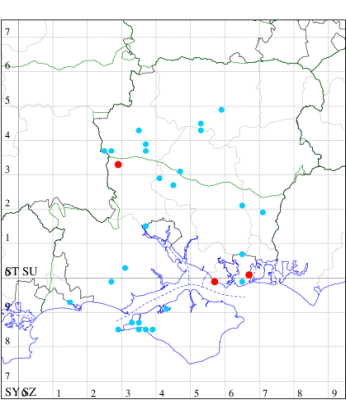
Records by year
Records by week (adult)
Records by week (larval)
Record Details
VC11: Broughton Down HIWWT NR, present, field observation, 15 Jun (RAC); Portsmouth, one, genitalia checked, 05 Jul (IRT); Browndown Coastal Ranges*, one, female, retained, 08 Jul (RJD, ADT, DWal & KJW det. RJD)
37.063 [B&F: 0544] Coleophora albicosta (Haworth, 1828) - Common
Common in rough grassland, downland and heathland throughout much of the British Isles. In Hampshire common in the south, and on the heaths in the north-east of the county, with scattered records elsewhere; no recent records from the Isle of Wight. Wingspan 12-15.5 mm. Imago is one of the more easily recognisable species, and well-marked specimens may safely be identified without recourse to dissection. Larva feeds within seedpods of Gorse, living within a movable case.
Records prior to 2022
| Vice County | #Records | #Individuals | First Record | Last Record |
|---|---|---|---|---|
| 10 | 8 | 4 | 1937 | 2020 |
| 11 | 205 | 326 | 1971 | 2021 |
| 12 | 54 | 94 | 1971 | 2021 |
2022 records
| Vice County | #Records | #Individuals | Max Quantity |
|---|---|---|---|
| 11 | 6 | 8 | 3 |
| 12 | 7 | 16 | 6 |
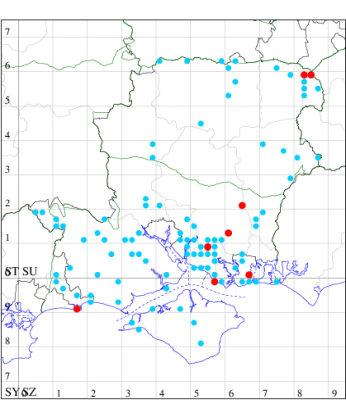
Records by year
Records by week (adult)
Records by week (larval)
Record Details
VC11: Botley Wood, one, male, 29 Apr (RJD, MLO, DWal, KJW det. RJD); Portsmouth, one, 05 May (IRT); West Walk, three, 13 May (RJD, MLO, DWal, KJW det. RJD); Old Winchester Hill, one, 27 May (RJD, MLO, ADT & DWal det. RJD); Hengistbury Head, one, 14 Jun (MJef det. AMD); Browndown Coastal Ranges, one, female, worn, det'd genitalia, 03 Jun (RJD, MLO, ADT, DWal & KJW det. RJD);
VC12: Yateley Common, one, 30 Apr; one, 27 May; two, 30 Apr; six, 27 May; three, 14 May; two, 14 May; Blackwater, one, 19 May (BGD)
37.066 [B&F: 0526] Larch Case-bearer Coleophora laricella (Hübner, [1817]) - Common
Common in woodland throughout much of the British Isles, except for the extreme north of Scotland, the Outer Hebrides, Orkney and Shetland (MBGBI Vol 3). In Hampshire and on the Isle of Wight recorded widely, but thinly, with the usual cluster of records in the south-east of the county, and probably under-recorded elsewhere. Wingspan 8-11 mm. Like many of the Coleophora, imagines are virtually impossible to identify without recourse to dissection, and the larvae, which live in cases of characteristic form and which can sometimes be found on the foodplant, may be easier to identify by comparison against a reference collection. Larva mines leaves of European Larch, living within a movable case, causing sufficient damage to be a serious pest in some areas.
Records prior to 2022
| Vice County | #Records | #Individuals | First Record | Last Record |
|---|---|---|---|---|
| 10 | 1 | 0 | 1983 | 1983 |
| 11 | 44 | 38 | 1981 | 2020 |
| 12 | 14 | 24 | 2004 | 2011 |
2022 records
| Vice County | #Records | #Individuals | Max Quantity |
|---|---|---|---|
| 11 | 4 | 22 | 10 |
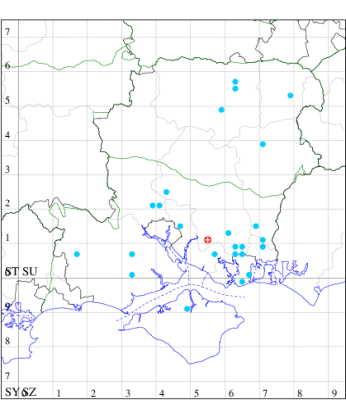
Records by year
Records by week (adult)
Records by week (larval)
Record Details
VC11: Botley Wood, case, one, on host-plant, on larch, occupied case, 24 Mar; case, 10, on host-plant, cases on larch 'easily found on two low branches, the only ones I could get at so clearly abundant in the larch block to the south of the railway line, 03 Apr (DPH); case, one, on host-plant, on Larch, 06 Apr (DWal)
37.068 [B&F: 0586] Coleophora adjunctella Hodgkinson, 1882 - Nationally Scarce B
Nationally scarce (Nb) in saltmarshes on the coast of England and Wales from Cumbria to Suffolk (MBGBI Vol 3). In Hampshire and on the Isle of Wight exclusively confined to the coast, where declining, and now largely restricted to the south-east of the county. Wingspan 8-11 mm. Like many of the Coleophora, imagines are virtually impossible to identify without recourse to dissection, and the larvae, which live in cases of characteristic form and which can sometimes be found on the foodplant, may be easier to identify by comparison against a reference collection. Larva feeds within seed capsules of Saltmarsh Rush, living within a movable case.
Records prior to 2022
| Vice County | #Records | #Individuals | First Record | Last Record |
|---|---|---|---|---|
| 10 | 4 | 0 | 1900 | 1987 |
| 11 | 19 | 15 | 1984 | 2017 |
2022 records
| Vice County | #Records | #Individuals | Max Quantity |
|---|---|---|---|
| 10 | 2 | 3 | 2 |
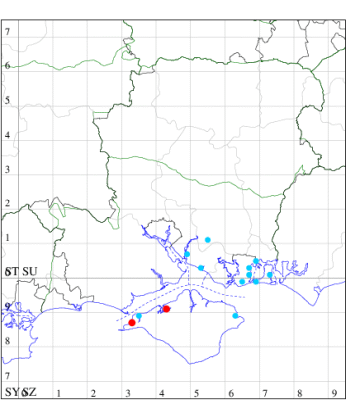
Records by year
Records by week (adult)
Records by week (larval)
Record Details
VC10: Totland, one, specimen retained, 27 May (RTer); Clamerkin Creek*, two, field observation, two specimens. Gen. det. 07 June, male, armature damaged,but appears to be Coleophora adjunctella. Second specimen Gen. det. 13 June confirmed adjunctella. Slide 20220613-01, 03 Jun (IOu)
37.069 [B&F: 0587] Coleophora caespititiella Zeller, 1839 - Common
Common in woodland clearings, damp meadows and marshes, both salt and fresh-water, throughout much of England, Wales and southern Ireland. In Hampshire widespread; the paucity of records from the Isle of Wight no doubt reflects historical under-recording, as evidenced by an increase in known range in recent years. Wingspan 8-10 mm. Like many of the Coleophora, imagines are virtually impossible to identify without recourse to dissection. Larva feeds within seed capsules of Compact Rush, Soft-rush, Jointed Rush, Hard Rush and Saltmarsh Rush, subsequently living within a movable case.
Records prior to 2022
| Vice County | #Records | #Individuals | First Record | Last Record |
|---|---|---|---|---|
| 10 | 5 | 2 | 1850 | 2021 |
| 11 | 475 | 1486 | 1972 | 2021 |
| 12 | 43 | 56 | 1995 | 2020 |
2022 records
| Vice County | #Records | #Individuals | Max Quantity |
|---|---|---|---|
| 10 | 1 | 2 | 2 |
| 11 | 4 | 4 | 1 |
| 12 | 2 | 2 | 1 |
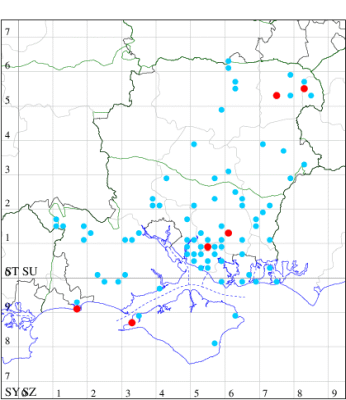
Records by year
Records by week (adult)
Records by week (larval)
Record Details
VC10: Totland, two, male gen.det, 02 Jun (RTer);
VC11: Botley Wood, one, male, det'd genitalia, 20 May; West Walk, one, male, det'd genitalia, 13 May (RJD, MLO, DWal, KJW); one, female, det'd genitalia. (3 lamps), 10 Jun (RJD, MLO & KJW); Hengistbury Head, one, gen det, 14 Jun (MJef det. AMD);
VC12: Odiham Common, one, swept, 03 Jun (BGD); Fleet Pond, one, 09 Jun (MHals)
37.070 [B&F: 0583] Coleophora tamesis Waters, 1929 - Local
Local in damp meadows, bogs and woodland rides throughout much of the British Isles. In Hampshire very infrequent on the south coast, from Southsea in the east to Keyhaven in the west, with a few old records from the north of the county. First recorded on the Isle of Wight in 2021. Wingspan 11-14 mm. Like many of the Coleophora, imagines are virtually impossible to identify without recourse to dissection, and best identified from the larval cases, found on the seeds of Jointed Rush.
Records prior to 2022
| Vice County | #Records | #Individuals | First Record | Last Record |
|---|---|---|---|---|
| 10 | 1 | 1 | 2021 | 2021 |
| 11 | 10 | 10 | 1985 | 2017 |
| 12 | 3 | 4 | 1967 | 1984 |
2022 records
| Vice County | #Records | #Individuals | Max Quantity |
|---|---|---|---|
| 10 | 1 | 1 | 1 |
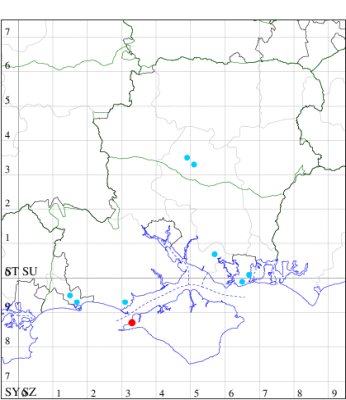
Records by year
Records by week (adult)
Records by week (larval)
Record Details
VC10: Totland, one, 1 x female gen. det, 27 Jun (RTer)
37.071 [B&F: 0582] Coleophora glaucicolella Wood, 1892 - Common
Common in marshes, fens, damp meadows, woodland rides and saltmarshes throughout much of the British Isles. In Hampshire and on the Isle of Wight occurs principally in the south of the county and the north of the Island, with isolated records in the north of the county, at Sherborne St John, Fleet Pond, Eelmoor Marsh and Winnall Moor. Wingspan 10-12 mm. Very similar to C. alticolella. Like many of the Coleophora, imagines are virtually impossible to identify without recourse to dissection, and the larvae, which live in cases of characteristic form and which can sometimes be found on the foodplant, may be easier to identify by comparison against a reference collection. Larva feeds on seeds of Compact Rush, Soft-rush, Hard Rush and Saltmarsh Rush, living within a movable case.
Records prior to 2022
| Vice County | #Records | #Individuals | First Record | Last Record |
|---|---|---|---|---|
| 10 | 18 | 6 | 1850 | 2021 |
| 11 | 233 | 305 | 1973 | 2019 |
| 12 | 10 | 5 | 1987 | 2008 |
2022 records
| Vice County | #Records | #Individuals | Max Quantity |
|---|---|---|---|
| 10 | 8 | 12 | 4 |
| 11 | 1 | 1 | 1 |
| 12 | 1 | 1 | 1 |
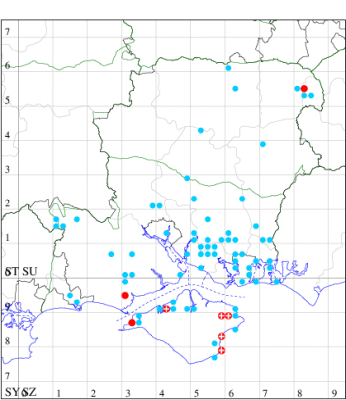
Records by year
Records by week (adult)
Records by week (larval)
Record Details
VC10: Totland, three, 28 Jun (RTer); Newtown Meadows, case, two, field observation, two cases collected from Compact Rush. Larvae examined, 24 Apr; Clamerkin Creek, one, field observation, gen. det. 13 June, 03 Jun; Luccombe, case, four, field observation, four cases found on Hard Rush on the slumped cliff at SZ 5839 7901. One larva removed and examined. Sclerite present on T3 and no spot on A9, 02 May; Lake, larva, one, field observation, soft-rush seed heads found with creamy-white cases. Four heads collected, the majority of cases found to be empty but one found to contain a larva. Gently removed and No spot on A9 and lateral sclerites on T1-3 roughly equal in size, 08 Apr; Hardingshute Farm, larva, present, field observation, larval cases on hard Rush, 09 Oct; Whitefield Farm, larva, present, field observation, larval cases on hard Rush, 09 Oct; New Bridge Pools, St Helens, case, one, field observation, placeholder. One larval case found, to be examined, 13 Apr (IOu);
VC12: Fleet Pond, one, 06 Jul (MHals)
37.073 [B&F: 0584] Coleophora alticolella Zeller, 1849 - Common
Common on heathland, damp meadows, marshes and a wide range of other habitats throughout much of the British Isles. Probably the most ubiquitous species of Coleophora occurring in the British Isles, having been recorded from almost every county and often in great abundance (MBGBI Vol 3). In Hampshire and on the Isle of Wight widespread and common, most frequent in the south-east. Wingspan 10-12 mm. Very similar to C. glaucicolella. Like many of the Coleophora, imagines are virtually impossible to identify without recourse to dissection, and the larvae, which live in cases of characteristic form and which can sometimes be found on the foodplant, may be easier to identify by comparison against a reference collection. Larva feeds on seeds of Soft-rush and Heath Rush, living within a movable case.
Records prior to 2022
| Vice County | #Records | #Individuals | First Record | Last Record |
|---|---|---|---|---|
| 10 | 40 | 19 | 1926 | 2021 |
| 11 | 357 | 663 | 1971 | 2021 |
| 12 | 41 | 32 | 1992 | 2020 |
2022 records
| Vice County | #Records | #Individuals | Max Quantity |
|---|---|---|---|
| 11 | 3 | 4 | 2 |
| 12 | 2 | 4 | 2 |
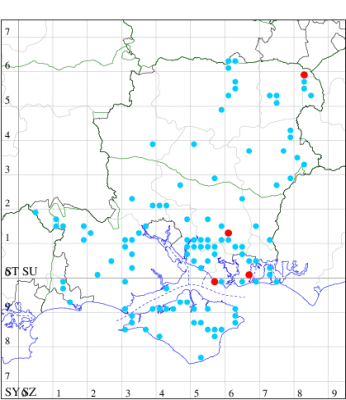
Records by year
Records by week (adult)
Records by week (larval)
Record Details
VC11: Portsmouth, one, genitalia checked, 11 Jul (IRT); West Walk, one, male, det'd genitalia. (3 lamps), 10 Jun (RJD, MLO & KJW); Browndown Coastal Ranges, two, female & male, det'd genitalia, 08 Jul (RJD, ADT, DWal & KJW);
VC12: Yateley Common, two, gen det, 14 May; two, gen det, 14 May (BGD)
37.074 [B&F: 0581] Coleophora taeniipennella Herrich-Schäffer, 1855 - Common
Common in fens, damp meadows and marshes throughout much of the British Isles. In Hampshire almost certainly under-recorded within other Juncus-feeding species, but recorded from areas such the New Forest, Botley Wood and Pamber Forest; recent work has found it to be relatively frequent in the west of the Isle of Wight. Wingspan 9-12 mm. Like many of the Coleophora, imagines are virtually impossible to identify without recourse to dissection, and best recorded by searching for the larvae, which live in cases of characteristic form on seeds of Jointed Rush and Sharp-flowered Rush.
Records prior to 2022
| Vice County | #Records | #Individuals | First Record | Last Record |
|---|---|---|---|---|
| 10 | 1 | 1 | 1978 | 1978 |
| 11 | 75 | 50 | 1973 | 2020 |
| 12 | 8 | 5 | 1975 | 2020 |
2022 records
| Vice County | #Records | #Individuals | Max Quantity |
|---|---|---|---|
| 10 | 3 | 3 | 1 |
| 12 | 1 | 34 | 34 |
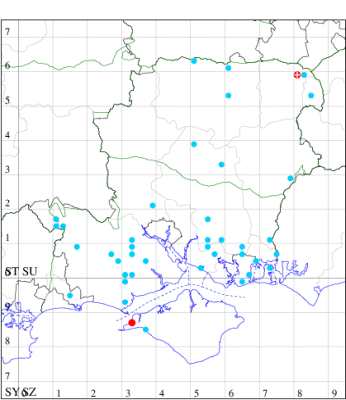
Records by year
Records by week (adult)
Records by week (larval)
Record Details
VC10: Totland, one, specimen retained, 03 Jun; one, 1 x female gen. det, 27 Jun; one, 1 x female gen. det, 28 Jun (RTer);
VC12: Minley Wood, case, 34, field observation, on Juncus acutiflorus, 15 Oct (BGD)
37.075 [B&F: 0575] Coleophora salinella Stainton, 1859 - Nationally Scarce A
Nationally scarce (Na) in saltmarshes throughout much of England. In Hampshire and on the Isle of Wight recorded only from the saltmarshes in the south-east of the county and on the Island. Wingspan 8.5-13 mm. Like many of the Coleophora, imagines are virtually impossible to identify without recourse to dissection, and the larvae, which live in cases of characteristic form and which can sometimes be found on the foodplant, may be easier to identify by comparison against a reference collection. Larva feeds on seeds of Sea-purslane, Grass-leaved Orache and Spear-leaved Orache, living within a movable case.
Records prior to 2022
| Vice County | #Records | #Individuals | First Record | Last Record |
|---|---|---|---|---|
| 10 | 6 | 0 | 1890 | 2006 |
| 11 | 66 | 75 | 1974 | 2021 |
2022 records
| Vice County | #Records | #Individuals | Max Quantity |
|---|---|---|---|
| 11 | 7 | 43 | 30 |
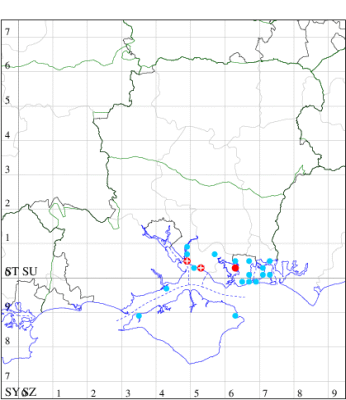
Records by year
Records by week (adult)
Records by week (larval)
Record Details
VC11: Hook Spit, case, four, on host-plant, on Sea Purslane, 26 Oct (DWal); Hook with Warsash, case, two, field observation, at least 2 cases, 20 Oct (DPH); Hill Head, case, four, on host-plant, cases on Sea Purslane. [Seen also by Dan Houghton, who found 'lots']. Distinguished from others on this foodplant by the pale, clean appearance of the cases, 19 Oct; Titchfield Haven NNR, case, one, on host-plant, on Sea Purslane, 26 Oct (DWal); case, 30, field observation, 30+ cases, one larva seen, 19 Oct (DPH); Horsea Island, one, female, det'd genitalia, 22 Jul (RJD, MLO, ADT, DWal, KJW det. RJD); Needs Ore NNR, one, gen det, 30 Jul (CNB det. DGib)
37.077 [B&F: 0552] Coleophora lassella Staudinger, 1859 - Nationally Scarce B
Nationally scarce (Nb) in bare muddy places and sand-dunes in the south-western counties of England and Ireland, and the Channel Island. In Hampshire mainly restricted to the south-east corner of the county, with a few records from bogs in the New Forest (with the first VC12 record in 2024); on the Isle of Wight, recorded at Yarmouth in 1992, but not subsequently. Wingspan 10-12 mm. Like many of the Coleophora, imagines are virtually impossible to identify without recourse to dissection, and the larvae, which live in cases of characteristic form and which can sometimes be found on the foodplant, may be easier to identify by comparison against a reference collection. Larva feeds within seed capsules of Toad Rush, living within a movable case.
Records prior to 2022
| Vice County | #Records | #Individuals | First Record | Last Record |
|---|---|---|---|---|
| 10 | 7 | 6 | 1992 | 2021 |
| 11 | 55 | 59 | 1968 | 2021 |
2022 records
| Vice County | #Records | #Individuals | Max Quantity |
|---|---|---|---|
| 10 | 8 | 15 | 4 |
| 11 | 2 | 2 | 1 |
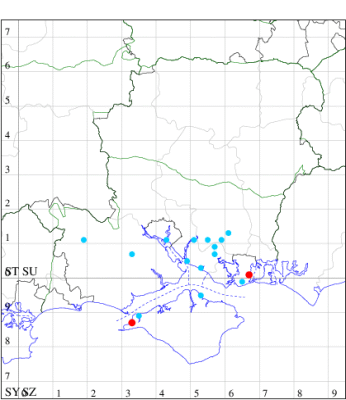
Records by year
Records by week (adult)
Records by week (larval)
Record Details
VC10: Totland, two, male gen.det, 27 May; one, male gen.det, 28 May; two, one male & one female gen. det, 23 Jul; two, male gen.det, 25 Jul; one, male gen.det, 26 Jul; one, 1 x female gen. det, 27 Jul; two, male gen.det, 28 Jul; four, male gen.det, 29 Jul (RTer);
VC11: Portsmouth, one, genitalia checked, 05 May; one, genitalia checked, 17 Jul (IRT)
37.081 [B&F: 0561] Coleophora therinella Tengström, 1848 - Nationally Scarce B
Nationally scarce (Nb) on waste ground and farmland in England, south of a line from The Wash to the Severn estuary, and in Ireland from the Burren district of Co. Clare (MBGBI Vol 3). In Hampshire occasional at light in the south-east of the county, at Botley Wood and in Southsea, outside this area, recorded only at Teg Down, Winchester, where the first cases ever to be found in Britain were discovered in August 1990. Not recorded from the Isle of Wight since 1900. Wingspan 13-16 mm. Very similar to C. peribenanderi, from which only separated in 1942. Like many of the Coleophora, imagines are virtually impossible to identify without recourse to dissection, and the larvae, which live in cases of characteristic form and which can sometimes be found on the foodplant, may be easier to identify by comparison against a reference collection. Larva feeds on seeds of Black Bindweed, living within a movable case.
Records prior to 2022
| Vice County | #Records | #Individuals | First Record | Last Record |
|---|---|---|---|---|
| 10 | 1 | 0 | 1900 | 1900 |
| 11 | 17 | 18 | 1972 | 2018 |
| 12 | 2 | 2 | 2010 | 2012 |
2022 records
| Vice County | #Records | #Individuals | Max Quantity |
|---|---|---|---|
| 11 | 1 | 1 | 1 |

Records by year
Records by week (adult)
Records by week (larval)
Record Details
VC11: Portsmouth, one, genitalia checked, 17 Jul (IRT)
37.083 [B&F: 0565] Coleophora saxicolella (Duponchel, [1843]) - Local
Local on waste ground, farmland and rough ground throughout much of the British Isles, but not in the Highlands or Islands of Scotland. In Hampshire widely distributed in small numbers, mainly inland; recorded once on the Isle of Wight, to light at Ventnor in August 1987. Wingspan 13-16 mm. Imago very similar to C. sternipennella, from which only reliably separated by dissection of the genitalia. Larva feeds on seeds of Orache and Goosefoot, living within a movable case. Case indistinguishable from those of C. sternipennella, C. versurella and C. vestianella.
Records prior to 2022
| Vice County | #Records | #Individuals | First Record | Last Record |
|---|---|---|---|---|
| 10 | 1 | 1 | 1987 | 1987 |
| 11 | 117 | 184 | 1972 | 2020 |
| 12 | 17 | 16 | 1967 | 2017 |
2022 records
| Vice County | #Records | #Individuals | Max Quantity |
|---|---|---|---|
| 11 | 2 | 3 | 2 |
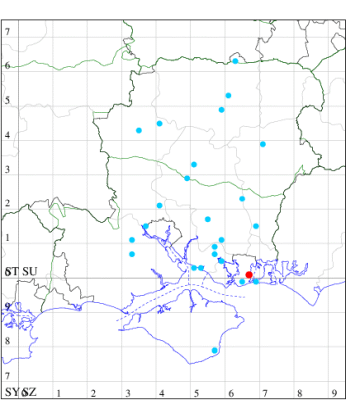
Records by year
Records by week (adult)
Records by week (larval)
Record Details
VC11: Portsmouth, two, genitalia checked, 13 Aug; one, 21 Aug (IRT)
37.084 [B&F: 0566] Coleophora sternipennella (Zetterstedt, 1839) - Nationally Scarce B
Nationally scarce (Nb) on waste ground, farmland and rough ground in England, south of a line from The Wash to the Severn estuary, but also in the north-eastern counties, North Wales and the Isle of Man (MBGBI Vol 3). In Hampshire more often on the coast that C. saxicolella, and virtually confined to Portsmouth and the surrounding area. First recorded on the Isle of Wight in 2024. Wingspan 10.5-15 mm. Imago very similar to C. saxicolella, from which only reliably separated by dissection of the genitalia. Larva feeds on seeds of Fat-hen, living within a movable case. Case indistinguishable from those of C. saxicolella, C. versurella and C. vestianella.
Records prior to 2022
| Vice County | #Records | #Individuals | First Record | Last Record |
|---|---|---|---|---|
| 11 | 36 | 36 | 1967 | 2014 |
| 12 | 4 | 4 | 2006 | 2021 |
2022 records
| Vice County | #Records | #Individuals | Max Quantity |
|---|---|---|---|
| 11 | 1 | 1 | 1 |
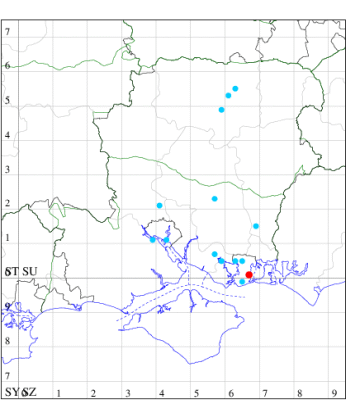
Records by year
Records by week (adult)
Records by week (larval)
Record Details
VC11: Portsmouth, one, genitalia checked, 09 Jul (IRT)
37.085 [B&F: 0569] Coleophora squamosella Stainton, 1856 - pRDB2
Scarce on waste ground, roadside verges and calcareous grassland in central southern and south-eastern England and the Breckland district of East Anglia (MBGBI Vol 3). In Hampshire known from a few locations, around Chilbolton in the north, where last recorded in 1992, and Horsea Island and Queen Elizabeth CP, Petersfield. A case observed at Micheldever, VC12 was the first for that vice-county for 30 years. Not recorded from the Isle of Wight to date. Wingspan 11-13 mm. The larva feeds on seeds of Blue Fleabane, living within a movable case.
Records prior to 2022
| Vice County | #Records | #Individuals | First Record | Last Record |
|---|---|---|---|---|
| 11 | 4 | 10 | 1985 | 2014 |
| 12 | 4 | 0 | 1979 | 1992 |
2022 records
| Vice County | #Records | #Individuals | Max Quantity |
|---|---|---|---|
| 12 | 1 | 1 | 1 |
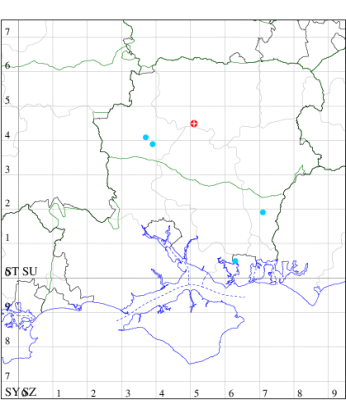
Records by year
Records by week (adult)
Records by week (larval)
Record Details
VC12: Micheldever*, case, one, field observation, 19 Sep (AMD)
37.086 [B&F: 0568] Coleophora versurella Zeller, 1849 - Local
Local on saltmarshes, waste ground and farmland in England and Wales, as far north as Co. Durham, and the Isle of Man (MBGBI Vol 3). In Hampshire largely restricted to the south-east coast, but there are a few inland records identified through dissection that indicate it is very likely to be more widespread than records suggest. Certainly, detailed work on the Isle of Wight since 2020 has indicated that it is likely to bre relatively common and under-recorded. Wingspan 11-15 mm. Imago very similar to C. sternipennella, from which only reliably separated by dissection of the genitalia. Larva feeds on seeds of Orache and Goosefoot, living within a movable case. Case indistinguishable from those of href="lep.php?code=37.083">C. saxicolella, C. sternipennella and C. vestianella.
Records prior to 2022
| Vice County | #Records | #Individuals | First Record | Last Record |
|---|---|---|---|---|
| 10 | 3 | 2 | 1938 | 2021 |
| 11 | 79 | 84 | 1968 | 2021 |
| 12 | 9 | 8 | 1965 | 2011 |
2022 records
| Vice County | #Records | #Individuals | Max Quantity |
|---|---|---|---|
| 10 | 4 | 4 | 1 |
| 11 | 1 | 1 | 1 |
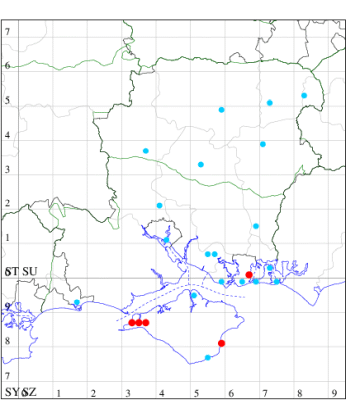
Records by year
Records by week (adult)
Records by week (larval)
Record Details
VC10: Totland, one, male gen.det, 28 Aug (RTer); Freshwater Fruit Farm, one, gen. det, 19 Sep; Freshwater, one, gen. det, 19 Sep (PBar); Shanklin Upper Chine*, one, gen. det. completed 23 May. Flight season is quoted as June-September which makes this rather early but the Gen. det. is clear. Only two previous IW records, 14 May (IOu);
VC11: Portsmouth, one, genitalia checked, 09 Jun (IRT)
37.088 [B&F: 0573] Coleophora atriplicis Meyrick, [1928] - Nationally Scarce B
Nationally scarce (Nb) in saltmarshes throughout much of England, Wales and western Ireland; the most widespread and common of the saltmarsh Coleophoridae feeding on Chenopodiaceae (MBGBI Vol 3). In Hampshire and on the Isle of Wight present in suitable habitat in the south-east of the county and on the north coast of the Island. Wingspan 12-14 mm. Like many of the Coleophora, imagines are virtually impossible to identify without recourse to dissection, and the larvae, which live in cases of characteristic form and which can sometimes be found on the foodplant, may be easier to identify by comparison against a reference collection. Larva feeds on seeds of Sea-purslane, Annual Sea-blite, Glasswort and Grass-leaved Orache, living within a movable case.
Records prior to 2022
| Vice County | #Records | #Individuals | First Record | Last Record |
|---|---|---|---|---|
| 10 | 10 | 9 | 1900 | 2013 |
| 11 | 54 | 45 | 1978 | 2020 |
2022 records
| Vice County | #Records | #Individuals | Max Quantity |
|---|---|---|---|
| 11 | 4 | 4 | 1 |
| 12 | 1 | 1 | 1 |
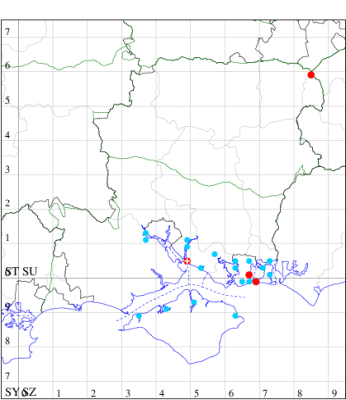
Records by year
Records by week (adult)
Records by week (larval)
Record Details
VC11: Hook Spit, case, one, on host-plant, on Sea Purslane (together with 4 C. salinella cases), 26 Oct (DWal); Hook with Warsash, case, one, field observation, 20 Oct (DPH); Portsmouth, one, genitalia checked, 15 Jun (IRT); Hayling Island, The Kench, one, at dusk, gen. det, 17 Jun (STho);
VC12: New Vice-county Record: Blackwater*, one, gen det, 16 Jul (BGD)
37.093 [B&F: 0559] Coleophora peribenanderi Toll, 1943 - Common
Common in rough grassland, waste ground, roadside verges and woodland rides throughout much of England and Wales, rare elsewhere. In Hampshire common in the south-east, but otherwise only sparsely recorded and apparently absent from the New Forest; on the Isle of Wight, generally uncommon. Wingspan 12.5-15 mm. Very similar to C. therinella, from which only separated in 1942. Like many of the Coleophora, imagines are virtually impossible to identify without recourse to dissection, and the larvae, which live in cases of characteristic form and which can sometimes be found on the foodplant, may be easier to identify by comparison against a reference collection. Larva mines leaves of Carduus, Cirsium and Arctium, living within a movable case.
Records prior to 2022
| Vice County | #Records | #Individuals | First Record | Last Record |
|---|---|---|---|---|
| 10 | 7 | 4 | 1981 | 2021 |
| 11 | 206 | 229 | 1975 | 2021 |
| 12 | 17 | 8 | 1982 | 2010 |
2022 records
| Vice County | #Records | #Individuals | Max Quantity |
|---|---|---|---|
| 11 | 1 | 1 | 1 |
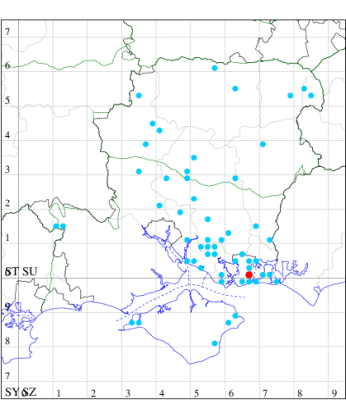
Records by year
Records by week (adult)
Records by week (larval)
Record Details
VC11: Portsmouth, one, genitalia checked, 12 Jul (IRT)
37.098 [B&F: 0554] Coleophora inulae Wocke, [1876] - Nationally Scarce A
Nationally scarce (Na) on Ploughman's Spikenard on dry downland and Common Fleabane in damp meadows, formerly in small colonies from Surrey to Caernarvonshire, but in recent years known only from south-east Hampshire, West Sussex and Herefordshire. In Hampshire restricted to Botley Wood and Portsea and Hayling Islands; on the Isle of Wight, and in North Hampshire, there have been no recent records. Wingspan 13-16.5 mm. Like many of the Coleophora, imagines are virtually impossible to identify without recourse to dissection, and the larvae, which live in cases of characteristic form and which can sometimes be found on the foodplant, may be easier to identify by comparison against a reference collection. Larva mines leaves of Ploughman's-spikenard and Common Fleabane, living within a movable case, over-wintering twice. Because of the biennial cycle, adults are likely to be found only in alternate years (MBGBI Vol 3).
Records prior to 2022
| Vice County | #Records | #Individuals | First Record | Last Record |
|---|---|---|---|---|
| 10 | 7 | -4 | 1900 | 1969 |
| 11 | 64 | 65 | 1975 | 2019 |
2022 records
| Vice County | #Records | #Individuals | Max Quantity |
|---|---|---|---|
| 10 | 1 | 1 | 1 |
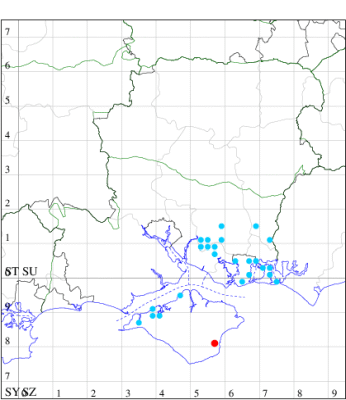
Records by year
Records by week (adult)
Records by week (larval)
Record Details
VC10: Shanklin*, one, gen. det. completed 12 August. confirmed as inulae. Slide 20220812-1, 08 Aug (IOu)
37.099 [B&F: 0553] Coleophora striatipennella Nylander [1848] - Common
Common in rough grassland, waste ground, woodland rides, damp woodland, marshes, river-banks and other damp areas throughout much of the British Isles. In Hampshire fairly well-distributed, with the usual concentration of records in the south-east, probably under-recorded elsewhere. First recorded on the Isle of Wight at Brighstone Down in 2009. Wingspan 11-13 mm. Like many of the Coleophora, imagines are virtually impossible to identify without recourse to dissection, and the larvae, which live in cases of characteristic form and which can sometimes be found on the foodplant, may be easier to identify by comparison against a reference collection. Larva feeds within seed capsules of Lesser Stitchwort, Common Chickweed, Common Mouse-ear and Water Chickweed, living within a movable case.
Records prior to 2022
| Vice County | #Records | #Individuals | First Record | Last Record |
|---|---|---|---|---|
| 10 | 4 | 3 | 2009 | 2019 |
| 11 | 121 | 132 | 1972 | 2020 |
| 12 | 25 | 29 | 1981 | 2017 |
2022 records
| Vice County | #Records | #Individuals | Max Quantity |
|---|---|---|---|
| 10 | 1 | 1 | 1 |
| 11 | 1 | 1 | 1 |
| 12 | 4 | 4 | 1 |
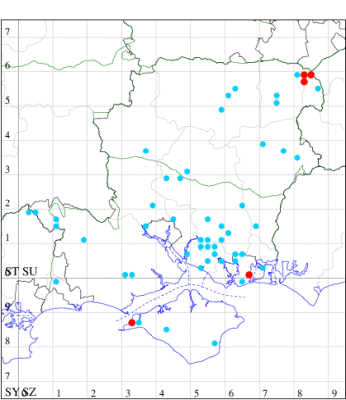
Records by year
Records by week (adult)
Records by week (larval)
Record Details
VC10: Totland, one, male gen.det, 26 Jul (RTer);
VC11: Portsmouth, one, genitalia checked, 17 Jul (IRT);
VC12: Minley Wood, one, swept, gen det, 08 May; Yateley Common, one, swept, gen det, 03 May; one, swept, gen det, 07 Jun; Blackwater, one, gen det, 16 Jun (BGD)
37.100 [B&F: 0525] Coleophora solitariella Zeller, 1849 - Nationally Scarce B
Nationally scarce (Nb) in hedgerows and open woodland in southern England, as far north as Lincolnshire, and eastern Wales (MBGBI Vol 3). In Hampshire and on the Isle of Wight recorded only a handful of times, mainly in the south of the county, with a two records from the Island. Wingspan 10-12 mm. Like many of the Coleophora, identification of the adult requires dissection, and finding the larval cases on Greater Stitchwort, where it lives within a movable case, is the best method of discovery.
Records prior to 2022
| Vice County | #Records | #Individuals | First Record | Last Record |
|---|---|---|---|---|
| 10 | 2 | 0 | 1977 | 2012 |
| 11 | 17 | 19 | 1960 | 2011 |
| 12 | 3 | 0 | 1900 | 2009 |
2022 records
| Vice County | #Records | #Individuals | Max Quantity |
|---|---|---|---|
| 11 | 2 | 176 | 88 |
| 12 | 2 | 6 | 5 |
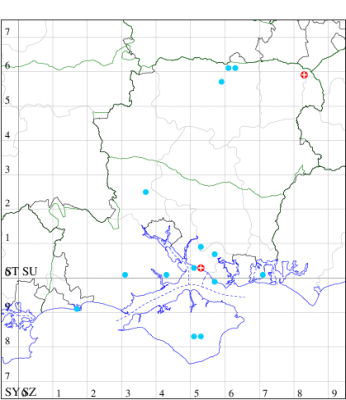
Records by year
Records by week (adult)
Records by week (larval)
Record Details
VC11: Thatcher's Copse, case, 88, on host-plant, up to 88 cases on greater stitchwort, 25 Apr; Brownwich, case, 88, field observation, 88 cases counted, some larvae observed, 25 Apr (DPH);
VC12: Yateley Common*, case, one, field observation, on Stellaria holostea, 15 Apr; case, five, field observation, on Stellaria holostea, 30 Apr (BGD)
37.102 [B&F: 0563] Coleophora argentula (Stephens, 1834) - Common
Common on waste ground and rough grassland, and by ditches and freshwater margins, throughout much of southern England, Wales and central Scotland. In south Hampshire, cases are common to abundant on yarrow, especially near the coast, but recorded less frequently in the north and on the Isle of Wight. Wingspan 9.5-13 mm. More frequently recorded in the larval stage, when the cases are fairly easy to find where they are present; the imago can be separated from several very similar Coleophora species only by dissection of the genitalia. Larva feeds on flowers and seedheads of Yarrow and Sneezewort, living within a movable case; case length 5-6 mm.
Records prior to 2022
| Vice County | #Records | #Individuals | First Record | Last Record |
|---|---|---|---|---|
| 10 | 24 | 17 | 1850 | 2021 |
| 11 | 161 | 112 | 1975 | 2021 |
| 12 | 44 | 35 | 1985 | 2020 |
2022 records
| Vice County | #Records | #Individuals | Max Quantity |
|---|---|---|---|
| 10 | 4 | 5 | 2 |
| 11 | 6 | 19 | 14 |
| 12 | 3 | 6 | 2 |
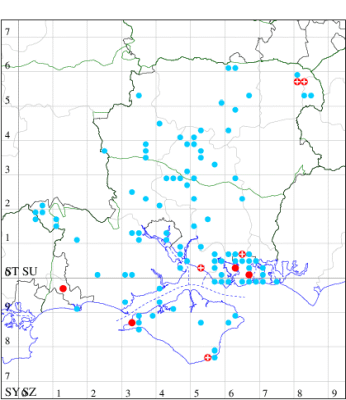
Records by year
Records by week (adult)
Records by week (larval)
Record Details
VC10: Totland, two, male gen.det, 25 Jul; two, male gen.det, 27 Jul; one, male gen.det, 28 Jul (RTer); Ventnor, larva, present, field observation, several cases on heads of Achillea millefolium, 16 Sep (PBar);
VC11: Brownwich, case, 14, field observation, 14 cases, 02 Oct (DPH); Horsea Island, one, female, det'd genitalia, 22 Jul (RJD, MLO, ADT, DWal, KJW det. RJD); Portsdown Hill, case, one, field observation, on dead seadheads of Achillea millefolium , 11 Feb (STho); Portsmouth, one, genitalia checked, 05 Jul; one, genitalia checked, 07 Jul (IRT); Hurn, one, gen det, 23 Jul (MJef det. PHS);
VC12: Minley Wood, case, two, field observation, on Achillea millefolium, 30 Jan; case, two, field observation, unoccupied larval case on Achillea millefolium, 01 Feb; case, two, field observation, on Achillea millefolium, 30 Jan (BGD)
37.103 [B&F: 0555] Coleophora follicularis (Vallot, 1802) - Local
Local in damp meadows, marshes, river-banks and woodland rides throughout much of Britain, but not in northern Scotland; occurs also in the southern half of Ireland and in the Channel Islands. In southern Hampshire, widespread and common in the east, notably in and around Botley Wood, and also recorded from the Beaulieu Estate and Needs Ore; very rare in the north of the county, where the only recent records are from Leckford, and on the Isle of Wight. Wingspan 13-15 mm. Very similar to C. trochilella, from which only separated in 1962. Like many of the Coleophora, imagines are virtually impossible to identify without recourse to dissection, and the larvae, which live in cases of characteristic form and which can sometimes be found on the foodplant, may be easier to identify by comparison against a reference collection. Larva mines leaves of Hemp-agrimony, Common Fleabane and Ploughman's-spikenard, living within a movable case.
Records prior to 2022
| Vice County | #Records | #Individuals | First Record | Last Record |
|---|---|---|---|---|
| 10 | 28 | 70 | 1981 | 2021 |
| 11 | 213 | 148 | 1973 | 2019 |
| 12 | 12 | 4 | 1981 | 2010 |
2022 records
| Vice County | #Records | #Individuals | Max Quantity |
|---|---|---|---|
| 10 | 2 | 2 | 1 |
| 11 | 1 | 2 | 2 |
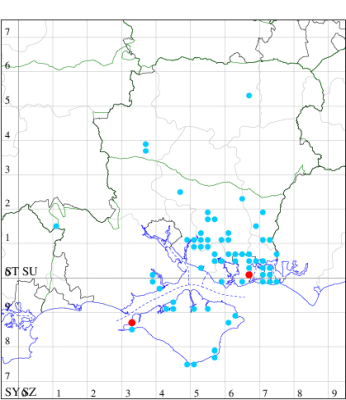
Records by year
Records by week (adult)
Records by week (larval)
Record Details
VC10: Totland, one, 1 x female gen. det, 02 Jul; one, male gen.det, 23 Jul (RTer);
VC11: Portsmouth, two, genitalia checked, 07 Jul (IRT)
37.104 [B&F: 0567] Coleophora adspersella Benander, 1939 - Nationally Scarce B
Nationally scarce (Nb) in saltmarshes, waste ground, farmland and fens throughout much of England and Wales, south of a line from The Wash to the Mersey estuary (MBGBI Vol 3). In Hampshire largely restricted to the south-east coast, with just a few inland records, including one in northern Hampshire, at Greywell in July 2004. Not recorded from the Isle of Wight to date. Wingspan 13-16 mm. Like many of the Coleophora, imagines are virtually impossible to identify without recourse to dissection, and the larvae, which live in cases of characteristic form and which can sometimes be found on the foodplant, may be easier to identify by comparison against a reference collection. Larva feeds on seeds of Grass-leaved Orache and Sea-purslane, living within a movable case.
Records prior to 2022
| Vice County | #Records | #Individuals | First Record | Last Record |
|---|---|---|---|---|
| 10 | 1 | 1 | 1973 | 1973 |
| 11 | 14 | 12 | 1975 | 2013 |
| 12 | 2 | 2 | 2004 | 2010 |
2022 records
| Vice County | #Records | #Individuals | Max Quantity |
|---|---|---|---|
| 11 | 1 | 1 | 1 |
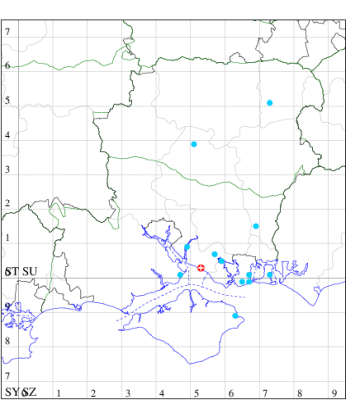
Records by year
Records by week (adult)
Records by week (larval)
Record Details
VC11: Titchfield Haven NNR, larva, one, field observation, case, larva seen, 22 Oct (DPH)
37.106 [B&F: 0560] Coleophora paripennella Zeller, 1839 - Local
Local on roadside verges, rough grassland and waste ground throughout the British Isles, as far north as Aberdeenshire. In Hampshire common in the south-east, especially in and around Botley Wood, but likely under-recorded elsewhere in both counties, particularly on the chalk where it is known from scattered locations. Wingspan 10-13 mm. Like many of the Coleophora, imagines are virtually impossible to identify without recourse to dissection, and the larvae, which live in cases of characteristic form and which can sometimes be found on the foodplant, may be easier to identify by comparison against a reference collection. Larva mines leaves of Creeping Thistle and Common Knapweed, living within a movable case.
Records prior to 2022
| Vice County | #Records | #Individuals | First Record | Last Record |
|---|---|---|---|---|
| 10 | 3 | 1 | 1978 | 2003 |
| 11 | 47 | 37 | 1974 | 2019 |
| 12 | 13 | 13 | 1980 | 2017 |
2022 records
| Vice County | #Records | #Individuals | Max Quantity |
|---|---|---|---|
| 10 | 1 | 1 | 1 |
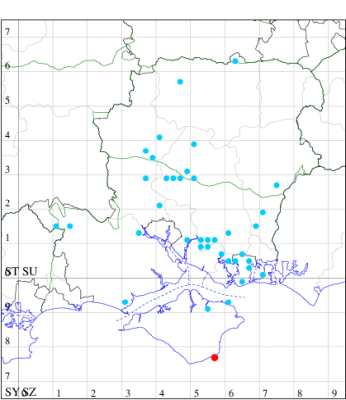
Records by year
Records by week (adult)
Records by week (larval)
Record Details
VC10: Wheelers Bay*, one, 11 Jul (ABut)
37.108 [B&F: 0588] Coleophora salicorniae Heinemann & Wocke, [1876] - Nationally Scarce B
Nationally scarce (Nb) in saltmarshes along much of the coast of England, from Cornwall to Yorkshire, and in parts of Wales. In Hampshire and on the Isle of Wight restricted to coasts in the south-east of the county and north-west of the Island. Wingspan 12-14 mm. Like many of the Coleophora, imagines are virtually impossible to identify without recourse to dissection, and the larvae, which live in cases of characteristic form and which can sometimes be found on the foodplant, may be easier to identify by comparison against a reference collection. Larva feeds within seeds of Glasswort, living within a movable case, buried in mud.
Records prior to 2022
| Vice County | #Records | #Individuals | First Record | Last Record |
|---|---|---|---|---|
| 10 | 6 | 8 | 1900 | 2019 |
| 11 | 120 | 168 | 1975 | 2020 |
2022 records
| Vice County | #Records | #Individuals | Max Quantity |
|---|---|---|---|
| 10 | 1 | 2 | 2 |
| 11 | 13 | 24 | 7 |
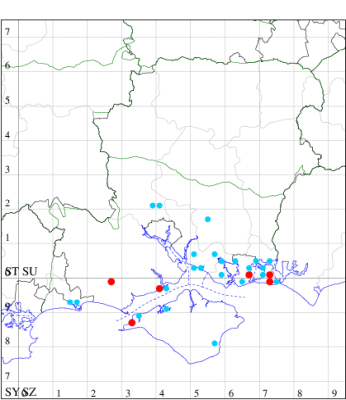
Records by year
Records by week (adult)
Records by week (larval)
Record Details
VC10: Totland, two, male gen.det, 27 Jul (RTer);
VC11: Portsmouth, one, 13 Jul; one, 18 Jul; one, 29 Jul; one, genitalia checked, 30 Jul; one, 03 Aug; three, 10 Aug; seven, including one gen det, 13 Aug; four, 14 Aug (IRT); Hayling, one, 30 Jul (STho); Sway*, one, 27 Jul (SKee det. MJW); Needs Ore NNR, one, 11 Aug; one, 13 Aug (CNB); Hayling Island, one, 18 Jul (STho)




